The War on Normal People: The Truth About America’s Disappearing Jobs and Why Universal Basic Income Is Our Future by Andrew Yang
My rating: 4 of 5 stars
I admit that I hardly paid attention to Andrew Yang during the primaries. I knew that he was for Universal Basic Income (UBI), but little else; and it did not seem to matter, given his pole numbers. But during the economic fallout caused by the coronavirus lockdowns, UBI is starting to look all the more reasonable (especially after I received a direct deposit from the federal government!). So I decided that it was time to take a second look.
This book could easily have been mushy pap—a boilerplate campaign book only published for publicity. Yang could have gone on and on about his good work in Venture for America, all the inspiring young people he met, all the businesses he helped grow, and all of the wonderful places he visited across America. He could have talked about his own story from first generation American to entrepreneur and politician. Some of that is in here, of course; but not nearly as much as one might expect. Instead, Yang has written a serious work on the problems facing America.
Yang covers a remarkable amount of ground in this short book—video game addiction, the importance of malls in communities, the rising cost of universities—but his primary message is fairly simple: Automation is going to eliminate many millions of jobs, and we need to transform the economy accordingly. As someone with many friends in Silicon Valley, Yang speaks convincing on the subject of automation. An obvious example is self-driving cars. Once the technology becomes reliable enough, virtually all driving jobs are threatened. Considering the numbers of people whose work involves transporting either passengers or cargo, this alone can be dramatic. What would happen to all the taxi, bus, and truck drivers of the world?
But according to Yang, self-driving cars would only be the beginning. While automation may call to mind robotic arms laboring in factories, white collar jobs are also liable to being automated. Chances are, if you work in an office, at least some of your work is rote and repetitive; and that means a computer could potentially do it, and do it far better than you can. While most of us are far removed from the world of artificial intelligence, those in the community routinely seem alarmed by the prospect of increasingly powerful A.I. Every year a new program accomplishes another “impossible” task, such as mastering the Chinese game Go. Yang even mentions computer-written symphonies and computer-generated artwork! (I was happy to note, however, that Yang did not seem to think teachers could be automated away.)
This will result in still more intense economic stratification. Many parts of America have already hollowed out as a result of recent economic trends. Most of the country’s factories have closed, destroying some of the most well-compensated blue-collar jobs. The rise of online retail—only accelerated by the coronavirus crisis—threatens to permanently destroy much more employment. Of course, when some jobs are eliminated, other types of jobs come into being. But we cannot rely on this process to correct the imbalance—first, because automation destroys more jobs than it creates (think of the one trouble-shooter for every five self-checkout registers), and second, because the new jobs usually require different skills, and exist in different parts of the country.
There are many proposed solutions in this book, but Yang’s signature idea is UBI. This would be a monthly payment of $1,000, or $12,000 a year, to every citizen over the age of 18; and it would be given a very patriotic name: the Freedom Dividend. Yang proposes to pay for this with a Value Added Tax (VAT) of 10%. (I was actually unaware of the difference between a VAT and a sales tax before reading this book, which is that a VAT must be paid at every step in the production process. This has the added advantage of taxing automated industries, since robots do not pay an income tax.) But the hefty price tag of UBI would also be partially compensated by the reduction or elimination of other government welfare programs. And, of course, if you put more money into the hands of consumers, most of them will spend rather than save it, and this will in turn increase tax revenue.
One obvious objection to UBI is that, by giving money indiscriminately, we will inevitably be giving it to people who do not need it. The most apposite reply to this objection, for me, is that subjecting government assistance to means-testing creates a host of problems. For one, there is a great deal of cumbersome bureaucracy involved in determining whether a particular person ‘deserves’ aide—bureaucracy that would be rendered entirely redundant by UBI, since the checks can be sent out through the IRS. Indeed, this cumbersome bureaucracy only creates added waste, since many NGOs exist simply to help people navigate the complex government paperwork. Of every, say, $100 spent on welfare, what portion of that goes to those in need, and what portion to the paychecks of bureaucrats laboring to determine who gets the money and how they can spend it?
Indiscriminate giving would also eliminate the pesky problem of disincentivizing work. At the moment, Republicans and Democrats are in a dispute over this very issue, as Republicans are arguing that the extra $600 of unemployment money (as part of the coronavirus aid package) will encourage people not to work. While some on the left disagree, personally I think this is a rather strong objection—not to giving people money, but to making the money conditional on not having a job. The same issue is present in many other sorts of government aid, such as disability payments, which cease as soon as the recipient becomes employed. If the money were unconditional, however, then people would have no disincentive to work; on the contrary, they would be able to substantially improve their economic situation by working, perhaps even making enough to start saving and investing.
UBI, then, has potential appeal for both those on the left and on the right. Those on the left may like it because it is a way of redistributing wealth, while those on the right may like it since it is a way of shrinking the government. The latter statement might seem more far-fetched, but I do think that a solid, conservative case could be made for UBI. After all, Milton Friedman was quite an avid supporter of the concept, for a multitude of reasons: it shrinks government, it reduces government paternalism, it promotes both work and consumption, and it would avoid dividing people into different categories.
This last point merits some comment. Presently, a great deal of anti-welfare rhetoric is concerned with parasitism—the idea that lazy people are simply ‘on the dole,’ dragging down the rest of society. It is the perfect recipe for shame and resentment, since inevitably it divides up society into groups of givers and takers; and even the best government bureaucracy in the world could not hope to distribute money in the fairest way possible. Inevitably, some people who ‘deserve’ aid will not get it; and others who do not ‘deserve’ it will—since no definition of ‘deserving’ will be perfect, and in any case there is no way of perfectly measuring how much somebody ‘deserves.’
UBI works against this psychology in a powerful way, by being entirely indiscriminate. Though the rich would be paying more in taxes than they receive back, they too would receive their monthly payment, and I think this fact alone would help create an added sense of social solidarity. UBI would be something shared by everyone, everywhere, rather than something that marks you out as being poor and dependent, a mark of stigma and shame. This strikes me as quite a positive thing in the age of dramatic political polarization.
Another aspect of UBI that I find deeply appealing is that it will give people the freedom to pursue less well-remunerated, but more socially beneficial, work. As Yang points out, many of the most humanly important jobs—being a parent, an artist, or even an online book reviewer—are quite poorly compensated, if they are compensated at all. An economist might argue that this is justified, since the free market determines the value of work based on supply-and-demand. But I think that this logic will become less appealing as robots start to out-compete humans. Indeed, perhaps automation will erode our faith in the wisdom of markets and meritocracy, since it will be difficult to believe that a delivery drone is more deserving than a delivery driver, even if it gets more work done.
There are, of course, many objections to UBI, one being that it will encourage widespread free-loading. But the evidence for this is quite weak. As Yang demonstrates, in the many UBI trials that have been conducted, work reduction was quite low, mostly taking place among new mothers. And as I mentioned above, our current welfare system arguably encourages free-loading far more effectively than UBI would, since UBI does not disincentive work. In any case, I think all of us—especially new mothers!—could do with a modest reduction in work hours, given the fact that study after study shows that long hours do not benefit productivity. Instead of having humans emulate work machines, then, it would be far better to automate as much work as possible—since machines never sleep, never eat, and never get sick—and focus on the remaining work which really does require a human touch.
Yang addresses many other objections to UBI, and most of his arguments are convincing. I do have one nagging question, however, and it is this: If the purchasing power of the general population is increased across the board, will prices of food and housing correspondingly increase? Though I am economically naïve, it strikes me that this is bound to happen, at least somewhat; and this may partially offset the gains of UBI. But perhaps I am mistaken. Another question is whether automation will go as far as Yang predicts. I found most of his forecasts—particularly about self-driving vehicles—quite compelling. But it does seem possible that the affects will be less sweeping than Yang supposes. For example, I cannot imagine couples turning to an A.I. marriage counselor with the voice of Morgan Freeman, as Yang somewhat fancifully imagines.
In any case, while Yang’s twin themes of automation and UBI are his central message, his book has far more to offer. I particularly appreciated his portrayal of the economic plight facing many parts of America, and the increasingly stark divide between those with and without a college degree. For example, I often find myself forgetting that the majority of American adults do not have degrees, if only because almost all of my friends and family have one. Considering how many jobs—including low-skilled jobs—require a degree, this is a major economic disadvantage nowadays.
The fact that I can forget about this economic disadvantage is a measure of the degree to which different parts of the country are insulated from one another. And the university system is not helping to even the playing field. After all, most of the people who do obtain degrees are already from comparatively better-off families. The university system also does not add to economic diversification, since students are pursuing an increasingly narrow range of majors; and after college, most graduates move to one of a handful of large cities. The result is an increasingly stark economic divide between Americans with college degrees living in large cities, working in a shrinking number of industries, and those living in more rural areas, or hallowed out cities, without degrees. It is an inimical process.
Yang also deserves credit for his mental flexibility. Besides UBI, this book contains a range of proposals, all of them quite new to me. Considering the degree to which political debate is dominated by decades-old proposals, I found this extremely refreshing. Admittedly, I do think that Yang’s Silicon Valley message failed to resonate with the voting public for a reason. While he has much to say about the future of America’s economy, he is less convincing on problems besetting many Americans now, most notably health care. Yang does favor a version of universal coverage, and he has some very intriguing things to say about how technology can change the role of the doctor, but I think it is fair to say that this was a minor part of his book.
Yet if this book fails as political marketing, it succeeds in being both a thoughtful meditation on the problems facing the average American, and a set of bold proposals to address these problems. While so many politicians come across as blindly ideological, stupidly partisan, or simply as creatures of the political system, Yang is intelligent, imaginative, and unconventional. I hope that this is not the last we hear from him.
View all my reviews
Month: May 2020
Review: Priced Out
Priced Out: The Economic and Ethical Costs of American Health Care by Uwe Reinhardt
My rating: 4 of 5 stars
Mantras about the virtues of markets are no substitute for serious ethical convictions.
There are a great many things for Americans to feel embarrassed about. Depending on your politics, you may bemoan the rise of identity politics and the snowflake culture predominating on college campuses; or perhaps you rage against racist policing or our lax gun laws. But I think that, as Americans, we can all come together and feel a deep and lasting shame over our health care system—specifically, how we finance it. According to Reinhardt, our system is so bad that it is routinely invoked in international conferences as a kind of boogey man, an example of what to avoid. And after reading this book, it is easy to see why.
I did not suspect that our system was quite so bad until I left the country. But, in retrospect, the evidence was quite apparent. Virtually all of my friends have expressed anxiety about their health care at some point—high premiums, high deductibles, or simply no health insurance at all. I have seen family members spend weeks negotiating with insurance companies for payment of their medicines (and even after the insurance chips in, the cost is still breathtaking). Meanwhile, in my five years here, I have yet to hear a single Spaniard express anxiety over how they will pay for a medicine or a medical procedure. Here, as in most of Europe, this type of anxiety is quite uncommon.
The U.S. system fails on many different fronts. Most simply, there is coverage. Millions of Americans have no coverage, and millions more have inadequate coverage (such as many of my friends, whose deductibles are so high that they may as well not have insurance). Second is cost. Both medical procedures and medicines are significantly more expensive in the United States. For example, the drug Xarelto (for blood clots) costs $101 in Spain, $292 in the U.S. The average cost of an appendectomy is $2,003 in Spain, $15,930 in America. A third failure— closely related to cost—is waste. Our byzantine payment system requires doctors and hospitals to spend great amounts of time and money communicating with insurance companies, which of course costs money, which of course gets transferred to the consumer.
But most fundamental failure is a failure of ethics. Or perhaps it is better to say a lack of ethical vision. As Reinhardt explains, while much of the debate on health care in America concerns itself with technicalities—risk pools, risk exposure, whether premiums should be actuarially fair or community-rated, etc.—this debate conceals the fact that we have yet to come to a consensus on the moral foundations of health care. Most of the world’s developed nations have established their systems on the presumption that health care is a social good. In the United States, on the other hand, we are sort of muddled, at times treating health care as if it is a commodity, and yet unwilling to face up to the implications of that choice—such as letting poor people die without treatment.
Aside from the ethical issues involved, health care has many features that make it unlike a typical commodity, and thus poorly governed by supply-and-demand. If I want to buy a car, for example, typically I am not in a great rush to do so. I can shop around, test-drive cars, compare prices across companies and locations, and read reviews. I can even decide that I do not want to buy a car after all, and instead buy a train pass. All of this contributes to control the price of cars, and incentivizes car companies to give us the best value for our money.
None of this is the case in our health care system. The demand is non-negotiable and, very often, time-sensitive. Furthermore, most patients lack the knowledge needed to evaluate what procedures or tests are justified or not, so oftentimes we cannot even be fully aware of our own ‘demand.’ Besides that, we have no ability to compare prices or to compare treatment efficacy. And even if we are careful to go to a hospital in our insurance network, there may be doctors ‘out of network’ working there, leading to the ugly phenomenon of surprise medical bills.
Added together, it is as if the car salesman blindfolded me, put a gun to my head, told me I had to choose a car in five minutes, while he was the only source of information about what car I needed (and medical bills can be quite as expensive as cars!). This is the position of the American “consumer” of healthcare.
My own brief experience with emergency medical care highlights the situation. The only time that I have ever been taken to an emergency room, I was unconscious. I woke up after being transported by the ambulance. Luckily, I was quickly discharged, and I also had insurance. But even though my insurance covered the hospital bill, it did not cover the ambulance, which I had to pay out of pocket. Again, I was lucky, since I was able to afford it. Many cannot, however, and have the experience of waking up from an accident, an injury, or an operation in debt. How can you be an intelligent consumer when you are unconscious?
The helplessness of the consumer creates a perverse incentive in our system. There is little downward pressure on prices. Instead, what results is a kind of arms race between health care providers and insurers. Insurers are incentivized to put up as many barriers as possible to paying out, which requires doctors and hospitals to invest ever-more resources into their billing departments, which of course only increases the cost to the patient. In many hospitals, there are more billing clerks than hospital beds; and when you realize that these billing clerks have their own counterparts in the insurance companies, you can get some idea of the enormous bloat created by our financing system.
I think there is a particular irony to this situation, since our American insistence on market values has created a labyrinthine network of incomprehensible rules, endless paperwork, and legions of bureaucrats—the very thing that capitalist principles were supposed to eliminate. Indeed, ironies abound in our system. For example, we endlessly discuss the affordability of government programs, while the tax incentives for employment-based insurance (which costs the federal and state governments an annual $300 billion in foregone revenues) is never mentioned. What is more, while the insurance mandates of Obamacare were roundly criticized as forcing the healthy to subsidize the unhealthy, as Reinhardt points out, the exact same thing occurs in insurance-based healthcare. And as a final irony:
It is fair to ask why, if socialized medicine is so bad, Americans for almost a century now have preserved precisely that construct for their military Veterans, and, indeed, why the latter are so defensive and protective of that socialized medicine system.
After reading this review, you may be excused for thinking that this book is a fiery manifesto about the evils of the system. Far from it. Uwe Reinhardt was a prominent economist and much of this book consists of tables and graphs. The writing is, if anything, on the dry side, and the tone is one of intellectual criticism rather than passionate outrage. Yet, strangely, this is why I found the book so effective. It is one thing for an arm-swinging socialist to condemn the evils of the system, but quite another for a calm economist to go through the data, point by point, and explain how it all works and how it compares with other countries’ performance.
You may also be excused for thinking that, given all this, Reinhardt would be an advocate for a single-payer system in the United States. After all, he was one of the architects of Taiwan’s single-payer system, which costs about 6% of the country’s GDP. (For comparison, America’s system costs us 17% of GDP!) But Reinhardt thinks that such a system would not work on American soil. For one, the libertarian streak in our culture runs too deep for such a system to be broadly acceptable. More importantly, however, Reinhardt thinks that our campaign finance system is so corrupt that the health care lobby would be able to exert a heavy influence on the government, thus canceling the benefit.
He instead advocates for an ‘all-payer’ system. The idea is to consolidate the market power of consumers by having standard prices set either by the government, or by associations of care providers and insurers. This would, at the very least, avoid the wild price variability that can be found in even a single city in the United States. It also helps to bring costs down, as demonstrated in Maryland, which has had an all-payer system for quite a while. Japan’s system is also established on this principle, and spends far less money per capita on its health care system, despite having a significantly older population than the United States.
In normal times, I was not exactly optimistic about the prospect of reforming out broken health care system. But in the wake of this pandemic, it does seem as if major reforms might not only be possible, but inevitable. Employment-based insurance makes little sense if people lose their jobs during a major health crisis, as has already happened to many millions of Americans. And high unemployment may persist for some time. What is more, a major health crisis, resulting in many thousands of additional hospital stays, will put pressure on private insurance firms and lead to a significant rise in insurance premiums. Basically, higher-risk patients create higher cost, and a pandemic puts far more people into the high-risk category. The greater strain on an already teetering system may be the proverbial straw on the camel’s back. We shall see.
Review: The Uninhabitable Earth
The Uninhabitable Earth: Life After Warming by David Wallace-Wells
My rating: 4 of 5 stars
You do not need to consider worst-case scenarios to become alarmed.
In normal times, the apocalypse bored me. Any discussion of catastrophic events put me in a mood of defensive skepticism. This was true whether I was considering an asteroid, a supervolcano, or rampant artificial intelligence—events that are so far out of my control that I would immediately dismiss them from my mind. However, the current coronavirus situation prompted me to read a book by epidemiologist Michael Osterholm, which includes a detailed prediction of what the next pandemic could look like. The experience of reading a scientist predicting, with considerable accuracy, what I was living through was profoundly eerie. And as a result, I was prepared to take a book about how climate change will play out a little more seriously
The picture is not rosy. Much like a pandemic, climate change it not localized, but strikes everywhere at once. If a bad hurricane hits one city, we can rush resources to the area. But if we are battered by massive hurricanes, destructive floods, severe droughts, raging wildfires, and deadly heatwaves, in many different parts of a country, over and over again, then we cannot effectively respond. To put it mildly, dealing with ever-escalating natural disasters will take an increasingly severe economic toll—measuring in the hundreds of trillions, by Wallace-Wells’s calculation—and will also put huge pressure on political systems, thus further reducing our ability to respond.
Wallace-Wells paints this coming future in such vividly chilling detail that even the most stoic reader will have an elevated pulse. Indeed, in this future world, the term “natural disaster” will start to lose its meaning, since disasters will be so common as to become simply become “weather,” and they will be, in part, caused by human activity. Millions may be displaced because of rising sea levels, at a time when we face food and freshwater shortages from drought and desertification. This is not a world that any of us would freely choose.
The tone lightens somewhat—from pitch-black to ashen gray—in the third section, where Wallace-Wells shifts from painting the looming threat to making some predictions about how our culture might respond. His conclusion, in a nutshell, is that the scope of the threat is so all-encompassing that we cannot psychologically come to terms with it. For example, many Americans are tempted to blame climate change on Republicans; but this obscures the fact that the Republican party is the only major climate-change denying party in the world, and the United States does not produce the majority of the world’s carbon emissions—not by a long shot.
Other common reactions to the crisis come in for criticism as well. One is to focus on individual behavior, trying to reduce consumption and to purchase the most eco-friendly items possible. But individual choices do not, Wallace-Wells thinks, have the potential to make more than the tiniest difference. For example, though there is much scolding of people, say, watering their lawns during a drought, personal water consumption is only a small fraction of the society’s total. Only large-scale changes in infrastructure can make the difference, and that must come from political pressure.
In both of these above cases, the common thread is the inability of our normal moral circuitry to deal with the problem. We want to tell a story with heroes and villains who are directly responsible through their personal choices for the crisis we are facing. But the reality, as Wallace-Wells says, is that culpability is widely-dispersed and our responsibility is collective, not individual. This goes sharply against the grain of our psychology, which I think partly accounts for our inaction.
One more common reaction is to think that technology will save us. There is, of course, very little evidence for this, and what it amounts to is using a blind faith in timely innovation to justify inaction. At the moment, carbon-capture technology is so inefficient that we would need hundreds of acres of such plants to make a difference. One other option is to start pumping ammonia into the air, in order to make the atmosphere more reflective of sunlight. But of course this would have quite awful effects on the environment and human health. And as Wallace-Wells points out, we have reached quite an odd stage in history when these ideas strike people as more practicable than reducing consumption of fossil fuels—as if the market were a more unbending force than the climate itself.
Advocates have a variety of emotions to choose from if they wish to motivate people—hope, outrage, and fear being the most common. Wallace-Wells leans heavily on fear, which arguably puts this book in the same tradition as Rachel Carson’s Silent Spring. But is fear the right choice? Certainly Carson was effective; and since Uninhabitable Earth was a #1 best-seller, it seems that Wallace-Wells achieved his goal. However, the challenge of getting rid of pesticides pales to nothingness in comparison with the challenge of reconfiguring our economies, infrastructures, and ways of life. Can fear propel us through this great transition? Personally, I found the tone of the book so bleak that I was exhausted even before reaching the end. But I suppose everyone will react their own way.
Will the COVID-19 pandemic make us more inclined to trust the warnings of scientists? I hope so, though perhaps that is asking too much. And as we collectively recover from the economic downturn, will we use the opportunity to pass something like the Green New Deal? I hope so, too, though I very much doubt it. Indeed, for me, one of the biggest lessons of this pandemic has been that we need not resort to selfish evil as an explanation for climate inaction. Virtually nobody had anything to gain from the pandemic, and it came anyway, catching every Western nation with its proverbial pants down—despite repeated warnings from epidemiologists. Human stupidity, then, is a sufficient explanation for our climate inaction. And, unfortunately, that will be around until the earth truly is uninhabitable.
[I did not scrupulously check for errors, but I still caught two. Well-Wallace says that “1 in 6” people die from air pollution, but the true figure is about 6-7%—still a lot, but much less than 1 in 6. Later on, Wallace-Wells says: “H.G. Wells’s The Time Machine, which depicted a distant future in which most humans were enslaved troglodytes, laboring underground for the benefit of a pampered and very small aboveground elite…” But of course this is an incorrect description of the book: most humans are not enslaved, but prey; and they live above ground, while the predators live below. It seems odd to me that he would reference a book that he clearly did not read. I am sure there are more errors lurking about.]
View all my reviews
Review: Mosquito
Mosquito: A Natural History of Our Most Persistent and Deadly Foe by Andrew Spielman
My rating: 4 of 5 stars
This is a thoroughly fascinating book about one of my least favorite things in the world. And I am one of the lucky ones. Even when those around me are getting eaten alive, I am normally spared the worst of the mosquito onslaught, for reasons that are largely elusive. Indeed, when I was an undergraduate studying in Kenya, one of my classmates did a small study on us, counting our bites and trying to see if they correlated with blood-type or other variables like perfume or shampoo. Since all of us had the same schedule, it seemed a promising study. But, alas, no insight was gained, though I was surprised to find that some of us had well over 60 bites, while I had less than 10.
Yet mosquitoes are more than annoyances; they are major vectors of disease, as I was reminded of daily when I took my malaria prophylactic. And after giving the reader some basic facts of mosquito biology, the book switches focus to disease control. There was much I did not know. For example, I had no idea that malaria was once present in New Jersey and New York, until aggressive government policies in the early 1900s eliminated the scourge. Similarly, I had no notion of the role that the Tennessee Valley Authority had in freeing America’s south from the malarial menace, largely by destroying mosquito nesting sites.
I also learned more about the story of Yellow Fever in the Americas. Though it may seem obvious to us nowadays that a disease can be transmitted by a mosquito bite, this was quite a controversial claim in the year 1900. It took careful work by a team of doctors in Cuba to prove that mosquitoes, not blood or bile, communicated the illness. This insight quickly led to the program of insect control that was instrumental in the building of the Panama Canal—a project that had proven impossible for the French, who labored under ignorance of the disease’s cause, and had to abandon the project as thousands of workers succumbed.
The authors of the book also have much to say on the subject of DDT. Having only read Rachel Carson’s Silent Spring, I had only been exposed to the argument against this popular pesticide. But Spielman and D’Antonio make a good case that, when used responsibly, the potential benefits of DMT far outweighs its health risks. Unfortunately, the pesticide was used to such a huge extent during the anti-malaria wars of the 1950s that it has lost much of its efficacy via accumulated resistance in mosquito populations. Spielman (the book’s entomologist) believes that this effort was ill-conceived, since it aimed for the impossible goal of total vector elimination, and it only resulted in the blunting of DDT, our most powerful weapon (not to mention decreased resistance in the human population from temporary reduction in malaria rates).
Malaria remains a major problem in vast areas of the world. We do not have an effective vaccine, and the plasmodium which causes the disease can evolve in response to drug treatments in just the same way that mosquitoes can evolve in response to DDT. And while those in temperate climates may be inclined to view it as a distant concern, this may soon prove not to be the case, as global warning expands the range of malaria-carrying mosquitoes northward. For my part, I think we are due for another big anti-malaria push, this time using smarter methods. But like the mosquito itself, the malaria parasite is one of our oldest enemies, having evolved with us for millions of years; so it may not be easy.
The authors close with a modern example of a tropical disease making it to a temperate zone: the 1999 West Nile outbreak in the New York City region. Surprisingly, I can remember this, even though I was only eight years old at the time. My mother told me that I had to stay inside on a beautiful summer night because they were spraying for mosquitoes. Soon, the helicopter came roaring by, dusting the area with insecticide. My brother remembers the entire playground in his Kindergarten being covered in a tarp to avoid getting sprayed. Such efforts did not succeed to eliminate West Nile in the United States, and now it circulates in the local bird and mosquito populations, closely monitored.
If the current pandemic helps to spur us to more aggressive public health measures, then I think mosquito control should be close to the top of the agenda. As Spielman himself notes, the mosquito does not serve any crucial functions in ecosystems—not as pollinators or even as prey—and are the most significant animal vectors of disease on the planet. Indeed, the mosquito is so perfectly useless and so perfectly dreadful that you wonder how anyone can maintain their faith in an almighty and infinitely loving God when faced with such a horrid product of blind evolution. They really are awful little things. And though we can never hope to eliminate them entirely, there is hope that we can break the chain of disease transmission long enough to at least make their bites mere itchy annoyances rather than a harbinger of doom.
View all my reviews
Quotes & Commentary #77: Camus
Really, however, it is doubtful if this could be called a victory. All that could be said was that the disease seemed to be leaving as unaccountably as it had come. Our strategy had not changed, but whereas yesterday it had obviously failed, today it seemed triumphant.
—Albert Camus
We humans are vulnerable to a variety of cognitive illusions, not the least of which is the illusion of control. The idea that an event is completely out of our control is extremely difficult for us to accept, apparently; and so our brain tricks us into thinking that we are the ones pushing the buttons. This can take many benign and amusing forms. For example, many of us repeatedly push the call elevator button or the crosswalk signal while waiting, with the idea that we can somehow speed it up. Or we leave the pit of an avocado in some guacamole, thinking we can prevent it from going bad.
This behavior often leads to superstitions, especially in situations when chance plays a major role. For example, baseball is notorious for the great many superstitions which abound, as players recruit supernatural intervention to reduce the role of chance. Fundamentally, these superstitions all make the mistake of confusing correlation for causation. So if a batter eats sixteen carrots and then hits a home run, he may conclude that the home run was due to the carrots.
And this process can take place on a societal scale. The classic example is, perhaps, the rain dance—an attempt to control weather patterns through ritual. Indeed, the idea that humans can influence the natural order through carefully prescripted and repeated gestures is arguably one of the psychological roots of religion.
The reason that I am bringing all of this up is that I believe we can observe this process quite clearly in our response to the coronavirus. All of us badly want to feel as though we can control the spread of the virus, and this has led to some sensible and, I suspect, some far less sensible solutions. I have observed several people in my neighborhood who put little bags on their dogs’ feet. Only slightly less ridiculous are the shoe disinfectant mats being sold online. Even the practice of wiping down our groceries with bleach strikes me as more ritualistic than sensible.
Indeed, considering that we can get the virus just from breathing in particles, then all this trouble to disinfect surfaces does seem rather suspect to me. I cannot help thinking that, by the time you touch an infected surface, you will have breathed in the virus ten times before. (And by the time you get it from your dog’s paws, you will have gotten it one hundred times before.)
Just as in superstition, irrational virus precautions can take place on a societal as well as an individual scale. The most notorious example of this I have seen was the bleaching of a Spanish beach, in the coastal town of Zahara de los Atunes. While undoubtedly causing significant environmental damage, the benefits to coronavirus control seem doubtful in the extreme. As another doubtful measure, I would offer Governor Cuomo’s decision to disinfect New York City’s subway system every night. Again, if the virus can be breathed in, then the threat from contaminated surfaces may be entirely redundant.
More generally, I think it is fair to say that we do not completely understand the pattern of coronavirus spread. A few days after announcing the nightly subway cleaning—a massive and expensive effort, which displaces the homeless and may impede some people’s commutes—Cuomo announced the results of a study on 600 people who were diagnosed with the virus in a hospital. He was surprised to find that only 4% had used public transportation. The large majority were not working. This result is puzzling. If mere exposure to the virus was enough, then one would expect the essential workers—especially those on public transport—to constitute a far larger portion of cases, since they come into contact with far more people.
Perhaps we have overestimated the importance of mere exposure, then, and underestimated the importance of “viral dose.” (Please keep in mind that I am in no way an expert, and this is pure speculation on my part!) This means that a long amount of time spent with one infected person could matter more than a passing proximity with several. If this is the case, then forcing people to stay in their homes, even if they have symptoms (which was the policy here in Spain), may be somewhat counterproductive, since it would increase the viral dosage of any co-residents.
This would also mean that prohibitions on outdoor exercise were not sensible. Indeed, over two weeks after finally letting children go outside in Spain, no noticeable uptick has been observed (despite complaints that people were not maintaining the correct distance). Other evidence points in this direction as well. This Chinese study could only find one single case of an outdoor transmission, and instead found that the vast majority of outbreaks took place inside the home.
Globally, the data also seems to indicate that we do not fully understand the relevant variables. The virus seems to be striking some countries hard while leaving others mostly untouched, in a pattern that is not easily explained either with governmental action or weather. The case of Spain and Portugal seems especially baffling, as Spain’s small neighbor has so far suffered five times fewer fatalities per habitant as Spain. And this, in spite of never having imposed mandatory stay-at-home orders or closing all non-essential businesses. Though Portugal is given credit for acting early, the two countries entered into a state of alarm at about the same time, closing schools and restaurants the same week. Yet the contrast is striking.
If we are going to effectively combat this virus, then I think this means doing our best to resist the illusion of control. This is because the cognitive illusion blinds us to the real effectiveness of our strategies. If we embark on a maximal strategy—doing everything we can think of to stop the virus—and the virus indeed abates, we may conclude that it takes a maximal strategy to beat the virus. But in that case, we may end up like the carrot-eating batter, drawing false conclusions from a mere correlation. And since so many individual measures are rolled into a maximal strategy, we remain in the dark as to which specific measures are the most helpful, which are basically useless, and which are counterproductive.
This information is vital if we are to achieve anything resembling a functional economy. Our goal should be to uncover which measures have the lowest cost-benefit ratio—inexpensive and minimally inconvenient strategies which effectively curb the virus. If indeed masks work, then widespread mask usage would be such a strategy, since they do not significantly disrupt normal life and cost mere pennies to produce. If it is not too late, increased security measures for senior care homes would be another such strategy, since age is a major risk factor.
Perhaps the easiest way to determine such measures would be surveys. Governor Cuomo has already demonstrated the knowledge that can be gained by surveying incoming hospital patients. Indeed, we probably should have been doing so from the beginning, allowing a more detailed picture to emerge of which activities tend to increase risk. Widespread serological testing for antibody prevalence can also be easily supplemented with detailed surveys. With any luck, certain patterns will emerge from this data, which will point us in the right direction.
Another way to find out more about how and where the virus spreads would be to turn our testing capacity away from patient diagnosis and towards investigative studies. This would mean testing representative samples from relevant populations, to ascertain the prevalence of the virus in different areas and professions. Such testing may reveal useful patterns in the virus’s spread. Contact tracing—once we have the ability to do so—can be similarly used as an investigative tool.
But as it stands now, I often get the impression that officials (here in Spain at least) are like a blindfolded boxer, swinging left and right hopping to connect with the target. The result is rather incoherent. For example, when people were finally allowed outside to walk and run, the officials decided to impose time constraints for these activities. I am not sure what they hoped to gain from this. But the result has been that everyone rushes out the door as soon as the clock strikes, and the streets are consequently packed.
Adding to this, officials decided not to open the parks, so there is less space for walking. To compensate, they tried converting several roads in the city into pedestrian zones. But I cannot help wondering: how is a pedestrian zone any safer than a park? Last weekend we were treated to the absurd spectacle of joggers squeezed into a narrow, tapped-off zone, jogging in one big circle around Madrid’s Retiro park, which remained closed.
Such policy mistakes are harmless enough, I suppose. But I think we need to be very wary of what this blind swinging can lead to. Traumatic events can provoke a panicked response that can do more damage than the threat we are trying to avoid. America’s last traumatic event—the September 11th attacks—provoked some very sensible changes, like increased airport security, but also set off a series of interventionist wars that cost far more lives than the original attacks themselves. Such wars seem rather absurd to many of us now; but at the time, when the threat of terrorism seemed to overshadow every other consideration, we were willing to react with a maximal strategy.
Does this crisis present us with a similar danger? I think it may. And if so, we need to do our best to avoid the coronavirus equivalent of an Iraq War, and focus on finding strategies equivalent to bomb screenings and reinforced cockpit doors—easy, cheap interventions that can save lives, rather than a giant quagmire that only adds another problem on top of the one we already have. If we are the blindfolded boxer, we need to focus on removing the blindfold, rather than swinging as hard as we can.
Review: Plagues and Peoples
Plagues and Peoples by William H. McNeill
My rating: 4 of 5 stars
Looked at from the point of view of other organisms, humankind therefore resembles an acute epidemic disease, whose occasional lapses into less virulent forms of behavior have never sufficed to permit any really stable, chronic relationship to establish itself.
It is risky to write a book like this. When William H. McNeill set out to analyze the manifold ways that infectious diseases have shaped world history, it was almost an entirely novel venture. Though people had been writing history for millennia, specialized works focusing on the ways that civilizations have been shaped by illness were few and far between. This seems rather strange when you consider that it was only in the twentieth century when disease reliably caused fewer casualties than enemy action during war.
Perhaps thinking about faceless enemies like viruses and bacteria simply does not come naturally to us. We personify the heavens readily enough, and do our best to appease it. But it is more difficult to personify a disease: it strikes too randomly, too mysteriously, and often too suddenly. It is, in other words, a completely amoral agent; and the thought that we are at the mercy of such an agent is painful to consider.
This tendency to leave diseases out of history books has come down to our own day. The 1918 flu pandemic is given a fraction of the coverage in standard textbooks as the First World War, even though the former caused more casualties. Curiously, however, that terrible disease did not even leave a lasting impression on those who survived it, judging by its absence in the works of the major writers of the day. It seems that memory of disease fades fast, at least most of the time. The 1968 Hong Kong flu killed 100,000 Americans that year (which would translate to 160,000 today), and yet neither of my parents remembers it.
This is why I think this book was a risky venture: there was not much precedent for successful books written about the history of diseases. Further, since there was not much in the way of prior research, much of this book must perforce consist of speculation using the spotty records that existed. While this does leave the historian open to the criticism of making unfounded claims, as McNeill himself says, such speculations can usefully precede a more thorough inquiry, since at least it gives researchers an orientation in the form of theories to test. Indeed, in my opinion, speculative works have just as important a role as careful research in the advancement of knowledge.
McNeill most certainly cannot be accused of a lack of ambition. He had completed an enormous amount of research to write his seminal book on world history, The Rise of the West; and this book has an equally catholic orientation. He begins with the emergence of our species and ends with the twentieth century, examining every inhabited continent (though admittedly not in equal detail). The result is a tantalizing view of how the long arc of history has been bent and broken by creatures lighter than a dust mite.
Some obvious patterns emerge. The rise of agriculture and cities created population densities capable of supporting endemic diseases, unknown to hunter-gatherers. Living near large masses of domesticated animals contributed much to our disease regimes; and the lack of such animals was decisive in the New World, leaving indigenous populations vulnerable to the invading Europeans’ microbes. Another recurring pattern is that of equilibrium and disturbance. Whenever a new disease breaks in upon a virgin population, the results are disastrous. But eventually stasis is achieved, and population begins to rebound.
One of McNeill’s most interesting claims is that the great population growth that began in the 18th century was partly a result of a new disease regime. By that time, fast overland and sea travel had exposed most major urban centers to common diseases from around the world, thus rendering them less vulnerable to new shocks. I was also surprised to learn that it was only the rise of modern sanitation and medicine—in the mid 19th century—that allowed city populations to be self-sustaining. Before this, cities were population sinks because of endemic diseases, and required constant replenishment from the countryside in order to maintain their numbers.
As I hope you can see, almost fifty years after publication, this book still puts forward a compelling view of world history. And I think it is a view that we still have trouble digesting, since it challenges our basic sense of self-determination. Perhaps one small benefit of the current crisis will be an increased general curiosity about how we still are, and have always been, mired in the invisible web of the microscopic world.
View all my reviews
San Francisco: In the Mist
California and New York have a relationship like many siblings. The two have much in common: they are wealthy, cosmopolitan, populous, and mostly liberal. And yet they drive each other crazy with their differences. Whereas New Yorkers are traditionally rude, uptight, stressed, and workaholic, the archetypical Californian is relaxed, gentle, happy, and obsessed with organic food and fair-trade coffee. Who is to say which is better?
I found myself reflecting on these differences as I walked off the plane that had taken me from JFK to the San Francisco airport, in the summer of 2018. The contrast was immediate. Any time you walk into JFK, you soon have someone yelling at you. But the airport here was calm and quiet. All the staff spoke to us in cheerful, polite tones. Of course, I was suspicious.
We were here to celebrate my cousin’s wedding, and to do some sightseeing in our free time. As it happens, all of my mother’s four siblings moved to California when they left home (whether from a hatred of NY or a love of Cali, it is unclear), which means that all of my cousins on my mother’s side were born and raised here in the sunny side of the country. It was inevitable that one of them would get married here.
My aunt picked us up from the airport. We were jet-lagged, tired, and quite hungry, and so we immediately headed to a restaurant. This meant a little bit of driving. Driving is fundamental to the Californian lifestyle; and since so many people live here, that means traffic is as well. But at least there are some nice places to drive. As a case in point, we were soon crossing the Golden Gate Bridge, probably the most famous bridge in our country (the only competition being the Brooklyn Bridge).

Now, when we were crossing this bridge, I am afraid that I mostly did not get a good look at it, since the bridge and its surroundings were shrouded in a thick fog. As I quickly came to appreciate, this is not unusual in San Francisco during the summer. The reasons for such abundant mist are rather elusive to me. Essentially, the fog forms because the air over land is heated more quickly than the air over the oceans. The hot air, then, rises, which means cold air is sucked in to replace it. And this cold air happens to be foggy, since it comes from the ocean. And as this process works best when the sun is hottest, San Francisco summers are foggy.
(The reason I say that this reasoning is elusive to me is that the same logic would seem to apply to any coastal city; but New York, Valencia, and Hong Kong are not foggy to such a degree.)
The climatic consequences of this are interesting. You can have hot sunny days a few miles inland, but in San Francisco itself it will be cool and misty—even a bit chilly. Indeed, Mark Twain famously wrote: “The coldest winter I ever spent was a summer in San Francisco.” That adage has a few problems, however, the first being that Mark Twain never actually wrote it. Another problem is that it is not true to begin with. Winters in New York are a lot colder, as Twain well knew.
Well, if I could see the bridge on that foggy afternoon, I would have seen one of the great engineering marvels of the world. At the time it was built (in the 1930s), the Golden Gate Bridge was the longest and tallest bridge on earth. The bridge connects the city of San Francisco with Marin County (where we were going to eat), spanning the entrance to the ample San Francisco Bay. It owes its fame, not only to its dimensions, but to its elegant design and bold orange color (the paint is called “international orange”), not to mention its dramatic location at the crossroads of land and sea.
Soon enough, we parked the car in the small town of Sausalito. Like the city of San Francisco, this town’s name preserves its Spanish origins (sauce means “willow tree”; sauzal means “a willow grove”; and sauzalito means “a little willow grove”). In the past, the town was a center of ship construction; but nowadays it is a touristy little town full of nice restaurants and cute shops, with a great view of the bay. We ate in an Italian restaurant and I felt greatly relieved. But our chit chat was interrupted when somebody said: “Is that Santana?” Everyone’s eyes turned to look at someone behind me.
“There’s no way that Santana is in this Italian restaurant,” I thought, and mentally justified not turning around. Then I saw somebody walk out of the restaurant: It was, indeed, the legendary guitarist Santana. This was my welcome to California.
San Francisco is located at the tip of a peninsula enclosing the eponymous bay. In many ways the city’s geography was its destiny. A center of commerce with limited land, the city had little choice but to expand upwards. These same factors determined the history of Manhattan; and, as a result, the two are among the most visually striking cities in the United States—a collection of spires rising out of the blue.
If you have gone to Catholic school, you may have guessed that San Francisco was named after St. Francis of Assisi. To this day, the oldest structure in the city is a small white building topped with a crucifix, a part of the Misión San Francisco de Asís, a holdover of the original Spanish mission to the peninsula. One must realize, then, that a city known for being a center of liberal politics, of the Summer of Love, of the gay rights movement, of the ultra-wealthy Silican Valley technicians, was named after a Catholic monk who took a vow of poverty. History is full of these delightful ironies.
We awoke early the next day (though still groggy from the jetlag) to begin our first day of exploring San Francisco. This time, we entered the city through the Bay Bridge, directly across the bay. This of course meant traffic and a toll. But it did provide a rather dramatic entrance to the city. At four and a half miles long (over 7km), the Bay Bridge is one of the longest bridges in the United States. It is not one continuous span, however, but two separate bridges linked to the Yerba Buena island in the middle of the bay. (“Yerba Buena” is a corruption of hierbabuena, which literally means ‘good herb,’ and is commonly used to refer to spearmint.)

This bridge has been reconstructed fairly recently. The original construction consisted of a suspension bridge on the west, and a cantilever bridge on the east. But an earthquake in 1989 damaged the eastern section, which eventually led to its being rebuilt with another, more stylish, suspension bridge, opened in 2013. Photos of the construction look very much like the construction of the new Tappan Zee bridge in Westchester, quite near my home, where another old cantilever bridge was replaced by a sleek and stylish suspension bridge. And, indeed, the same barge crate was used in both constructions: the Left Coast Lifter, an enormous contraption painted patriotic red, white, and blue, used to heave big pieces of bridge into place.
On a clear day, the Bay Bridge would afford you a magnificent view of the city. On this particular day, however, it gave us a rather less magnificent view of gray fog. But this did lend the city an intriguing air of mystery.
Our first stop was Coit Tower. This tower is not exactly conspicuous amid the skyscrapers now crowding the city; but when it was built, in the 1930s, this was the finest view in town. The tower is of fairly modest dimensions, about 200 feet tall. But it stands on Telegraph Hill, one of the hilly city’s tallest and most ideally situated hills. This makes the tower a wonderful place to enjoy the view—when it is not foggy, that is. In any case, the tower is interesting in itself. Made of unadorned concrete, it has a vaguely industrial shape, perhaps like a sprinkler. Considering that the tower is dedicated to fallen firefighters, many have surmised that it was to look like a fire hydrant. The resemblance is apparently coincidental, however.

Coit Tower owes its name to Lillie Hitchcock Coit, a wealthy dowager who patronized the volunteer fire department, and who left money in her will for the beautification of the city. I would say that the money was well spent, considering the tourists crowded into every inch of the building. We entered, paid the fee, and went up to the top. The building is narrow and there is only one small elevator providing service up and down. In any case, as soon as I reached the roof, I wanted to turn back. It was rainy, the wind was howling, and the fog put a damper on the view.
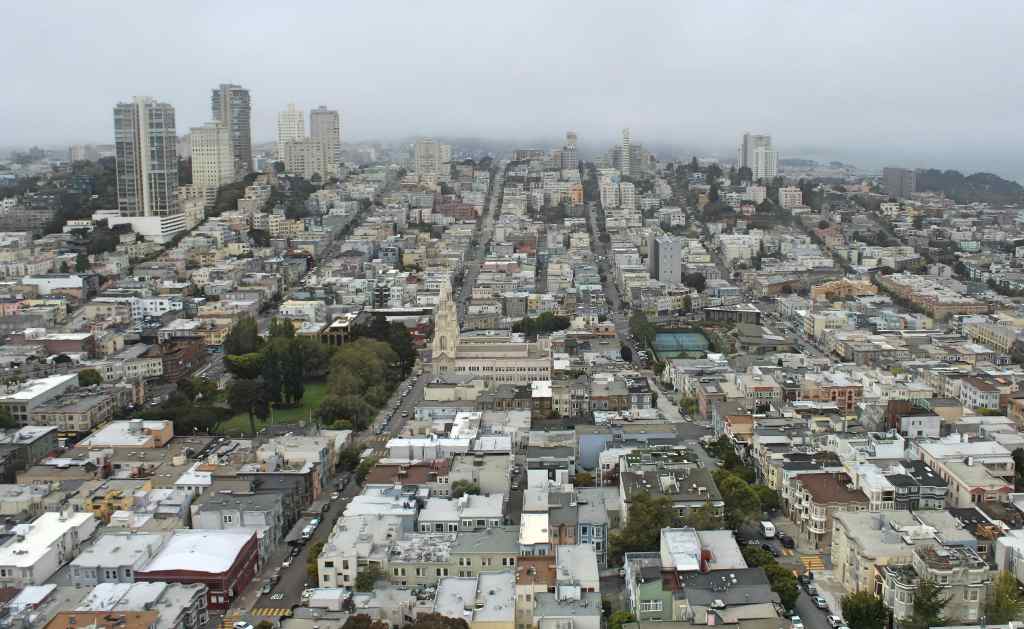
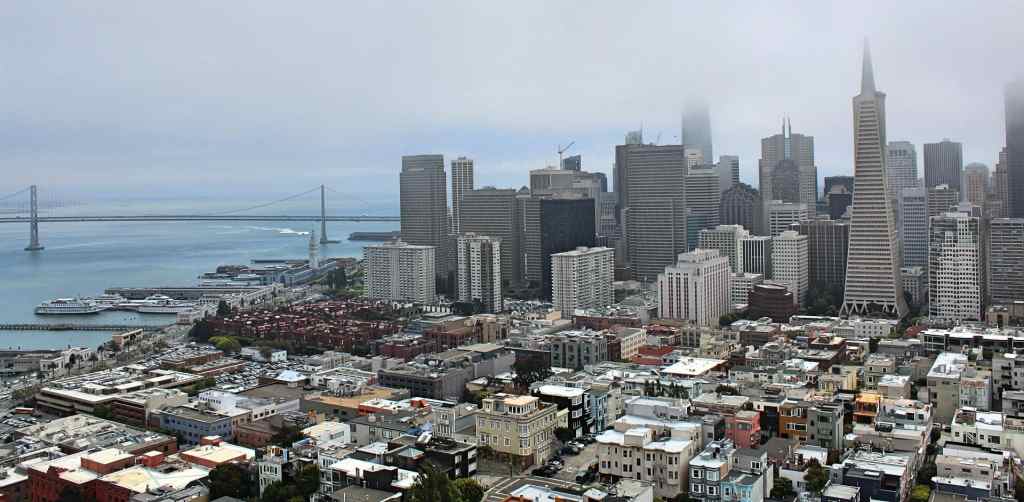
But Coit Tower has much to offer besides its view. On the bottom floor, there is a continuous mural running across the outer and inner walls of the hallway. It is detailed and impressive work, done during the height of the Great Depression, under the auspices of the Public Works of Art Project. Indeed, Coit Tower was the pilot project of this organization, an experiment in using public funds to employ artists to beautify public buildings. The results are still heartening. The murals are done in a Social Realist style, showing stylized scenes of America.

What makes the art “social realist” is not so much that the paintings are particularly realistic, but that they attempt to encapsulate the everyday American experience. Thus, we see street life, factories, and farms, rather than saints, heroes, or Greek gods. Personally I found the murals both aesthetically pleasing and even vaguely inspiring—showing pride and faith in our sprawling country. Certainly, such a thing seems very distant nowadays. Perhaps we ought to bring back the Public Works of Art Project. I am sure there are still lots of needy artists willing to paint inspirational scenes in public spaces.
After this we headed to the Financial District. Anywhere money is centered, big grey buildings are likely to follow; and so this is where the city’s skyscrapers are found. When you factor in the regular grid pattern of the streets, the final result looks remarkably similar to midtown Manhattan (though not as dirty). The Financial District even has its own Wall Street, in the form of Montgomery Street, one of the country’s great concentrations of capitalist activity.
For over forty years—from 1971 to 2017—the skyline of San Francisco was dominated by the Transamerica Pyramid, a daring modernist triangle of glass and steel. Even now, the building seems futuristic in its design. The same cannot quite be said for its younger brother, the Salesforce Tower, which surpassed the pyramid upon its completion in 2017. It is difficult to find anything positive to say about this building’s design. Its shape calls to mind objects not normally mentioned in polite conversation, and its bloated form does not harmoniously blend in with the San Francisco skyline, but dominates and disrupts the picture. I must admit, however, that the building is an impressive technical achievement, since erecting safe skyscrapers in the seismically-active city is no easy feat.

For lunch, we headed to Yank Sing, a dim sum restaurant in the famous Rincon Center. The building itself has an elegant art-deco design. But it is most notable for the murals inside, which also date from the Federal Arts Project. The best murals are to be found in the old post office, and were painted by the Russian immigrant Anton Refregier. They are also part of the social realist tradition, and treat of the history of San Francisco—covering major events, like the 1848 gold rush, the 1860 completion of the trans-continental railroad, and the horrible 1906 earthquake. Refregier’s sense of injustice and oppression caused some controversy, as it led him to portray some of the less attractive scenes of American history—a choice that got him into trouble as a communist sympathizer during the Red Scare. Thankfully, the murals have escaped destruction by bigots.

After we finished eating and enjoying the art, we got back in the car to head to the most iconic stretch of asphalt in the entire city: Lombard Street. This is a twisting street, consisting of eight hair-pin turns, that leads down one of San Francisco’s many hills. I have never seen anything else like it. The last time I had visited San Francisco was over ten years earlier, when I was quite young, and I still had a vivid memory of this road—so crazily misshaped. On this particular summer day, as the fog began to clear, the street was quite beautiful. Flowers bloomed in the little gardens beside the pavement, and plants even colonized one colorful house nearby.
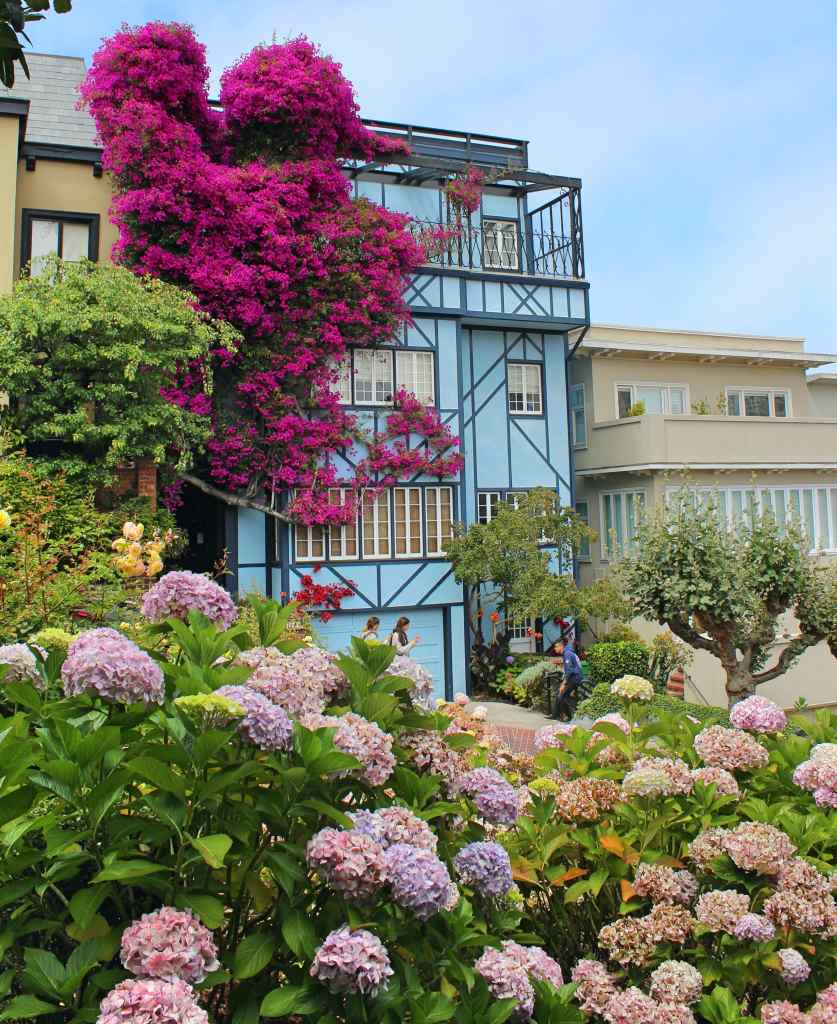
This seems like an appropriate time to discuss San Francisco’s topography. Like Rome itself, San Francisco claims to have been built on “seven hills,” though there are an awful lot more than seven hills in the city. Indeed, there are six times more: 42 hills, ranging in height from 200 to over 900 feet tall. I can only imagine that the city’s marathon is punishing on one’s knees, and that owning a car means frequent brake repair. It is probably due to this inclination that San Francisco developed its famous cable car system—one of the city’s most identifiable symbols. In its hilliness and its in street cars, this Californian city has an intriguing resemblance to Lisbon, a city with its own big orange bridge.


Now we decided to visit the city’s most famous book store: City Lights. I must confess that I had never heard of it, and I walked out thinking that it was just a particularly nice shop. But my dear mother soon informed me that it was this humble store which published Allan Ginsberg’s iconic collection, Howl and Other Poems, in 1956—a pivotal moment in the Beats movement, as the resulting obscenity trial changed censorship practices and catapulted Ginsberg to national fame. When I found this out, I went right back inside and bought myself a copy of this poem. (Fortunately, after the store’s continued existence was threatened by the coronavirus lockdowns, an online fundraiser helped to save the business.)

After this adventure in literature, we retreated to the nearby Caffe Trieste for some caffeine. This is an elegant little establishment which holds the distinction of being the first Italian-style café on the West coast. As you might expect, having a quality coffee house near a center of the Beats movement meant that this spot also became a meeting-point for literati, like Alan Watts, Jack Keruac, and Alan Ginsberg himself. But I was mostly struck by the prices. Coffee in San Francisco is not cheap! Indeed, ever since we landed, everything I saw seemed absurdly expensive to me; and this is no coincidence.
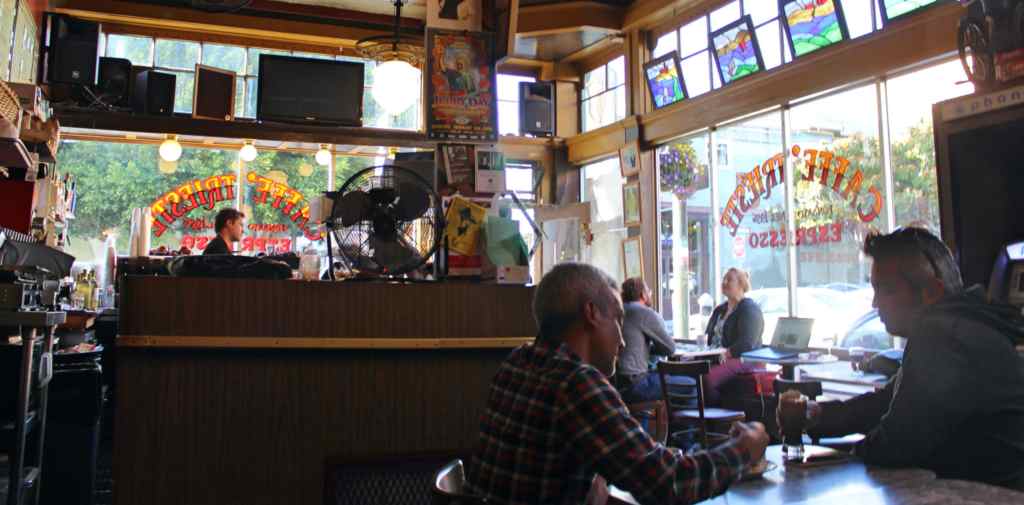
Though San Francisco was the center of the Beats movement, the setting of the 1967 Summer of Love, and in the 1980s the epicenter of gay liberations, nowadays the city has gone the way of so many major cities—it is simply too expensive for anyone but high-earners to live there. A big part of this is due to the proximity of Silicon Valley, just a few miles south. The influx of big business has made the cost of living shoot up: the typical rent is higher than $4,500, and the typical house costs well over one million. According to this article, homelessness has increased by 17% in the last two years alone (and who knows how the coronavirus depression will affect that!). In short, it is not a great city to visit if you wish to travel on a budget.
Hippiedom and corporations aside, there are some traces of religion left in the coastal city. I have already mentioned the old San Francisco mission. There are some impressive church buildings as well, such as Grace Cathedral. This is the city’s Episcopal cathedral. The structure was completed in a resplendent neo-gothic style, doing a convincing imitation of Paris’s Notre-Dame. Yet the church doors are not gothic, but Renaissance in style; indeed, they are full-scale replicas of the Gates of Paradise. These are a set of bronze doors by Lorenzo Ghiberti, made for the baptistry of Florence, now considered to be great masterpieces of the early Renaissance. The replicas in San Francisco are wonderfully done, and were just as enjoyable to examine. The interior of the cathedral is quite as majestically gothic as the outside, with gilded paintings and stained glass illuminating the stone space. It even has a replica of Chartres’s labyrinth.


Not far off is the city’s catholic cathedral, Saint Mary’s. Completed in 1971, the building is so oddly shaped that you could be forgiven for not thinking it was a place of worship. To me, it resembles an enormous washing machine agitator, ready to rinse off the sky. While I am not an enemy of modern architecture, I do think that churches ought to be a bit more solemn and less, well, ridiculous in appearance. This church was built to replace the original cathedral, which had been standing since 1854. Reduced to the status of a humble church, this building still stands, now called Old St. Mary’s. While no architectural marvel, the simple brick building does have the conspicuous advantage of looking like a church.
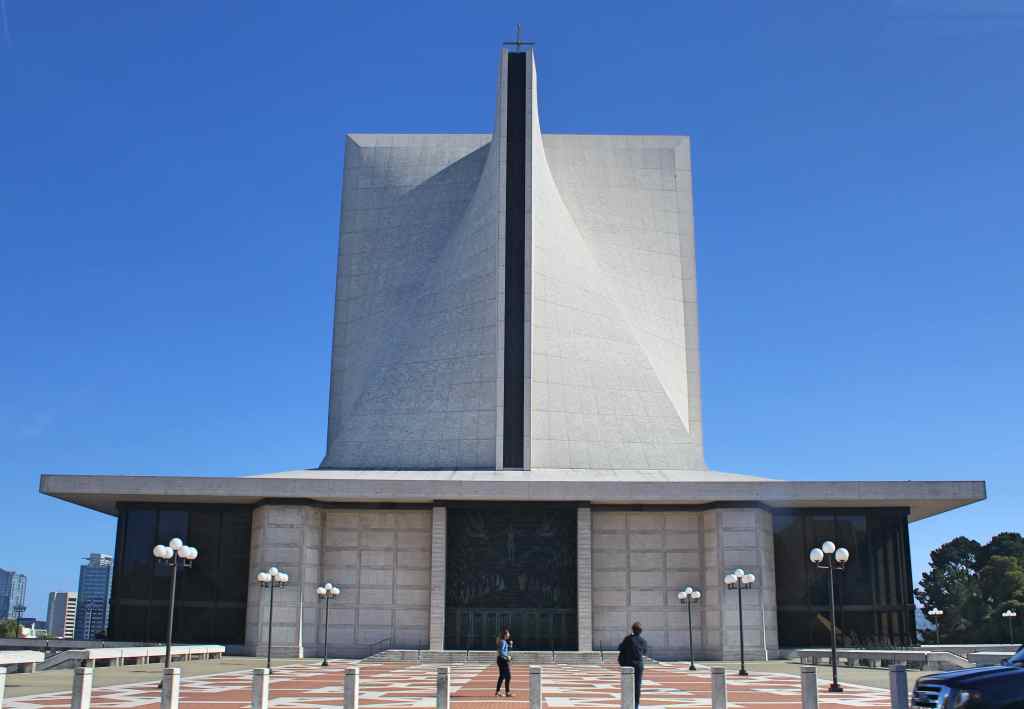
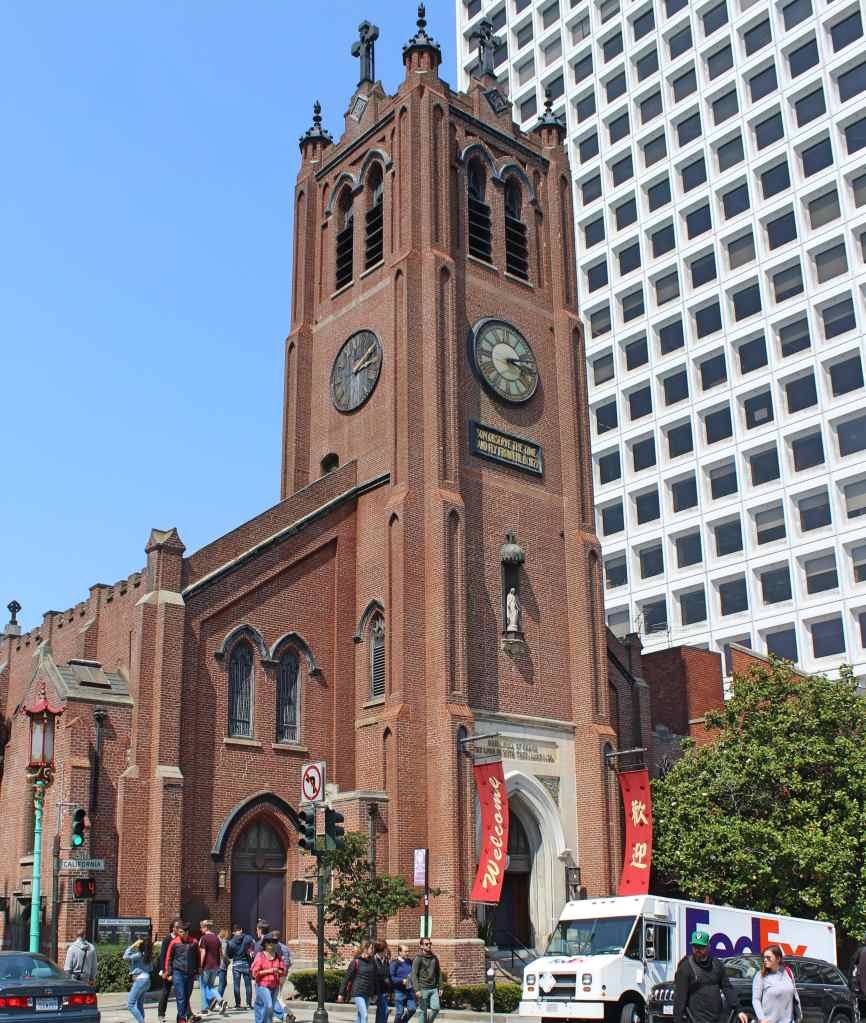
Perhaps the most beautiful catholic church in the city is Saint Peter’s and Saint Paul’s. It is a pale white building with two long, narrow spires. The interior is quite lovely, with a coffered ceiling leading to a semi-dome above the main altar. The church even has a full-scale replica of Michelangelo’s Pietá—and it is extremely well-done. A center of the Italian-American community, the church holds services in Italian as well as in English. Somewhat more surprisingly, the church also holds services in Cantonese!

After some milling about in town, we got back in the car for the day’s final destination: Lands End. As you might have guessed, this is one of the many spots in San Francisco where earth meets water. More specifically, this is a park near the mouth of the bay. It is quite a romantic spot, with shrubby trees clinging to rocky soil, with the wind and the waves crashing in. The visitor’s center sits above a kind of rocky crater, beside which stand some ruins of old structures. This is all that remains of the famed Sutro Baths, an enormous complex of swimming pools that used to attract thousands of visitors.

I took some time to walk along the shoreline. The landscape is beautiful and dramatic, with whitecaps washing over sunbleached rocks, and the rolling hills crawling out from under the screen of fog. As I walked on, the Golden Gate Bridge came into view—still partially shrouded by the mist, but magnificent nonetheless.

I also noticed something strange in the water, a sort of concrete stump in the middle of the bay. I learned from a nearby sign that this is the Miles Rock Lighthouse. It was built after the SS City of Rio de Janeiro ran into a submerged reef and sank in 1901, killing 135 of the 220 on board. Originally, this lighthouse—which is built on a lonely rock—had the recognizable form of a tower, but in the 1960s the top floor was demolished in order to make room for a helicopter landing pad. Nowadays, the lights are automated, so nobody has to sit there, alone, in the middle of the foggy bay.
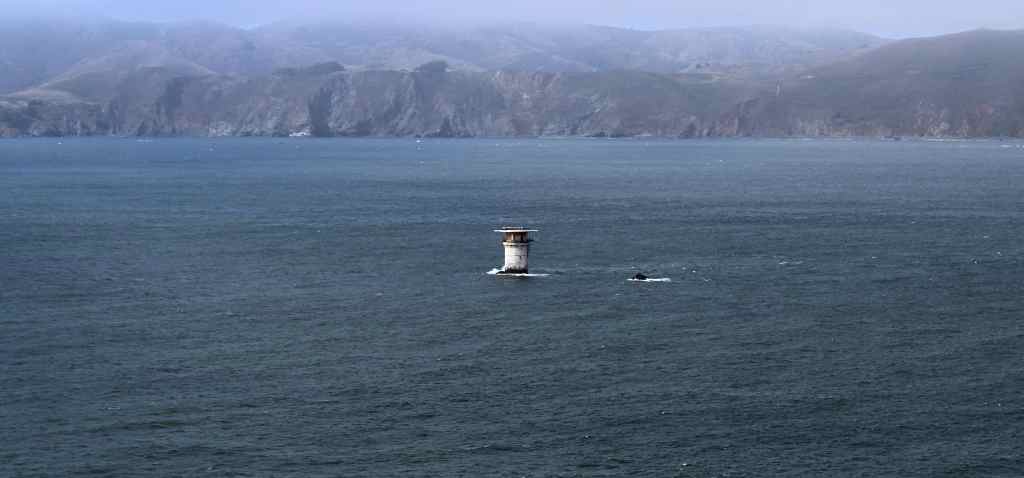
So ended my first day in San Francisco. We got back into the car and drove by the famous Cliff House restaurant, which overlooks the Seal Rocks (both of these very accurately named). Then, after a pizza dinner, we were on our way back to the suburbs. But I would return.
San Francisco is blessed to have the rail system with the dorkiest name in the country: BART, which stands for Bay Area Rapid Transit. For my next day in the city, I hopped on the BART by my aunt’s house in the suburbs, and disembarked at the Embarcadero. This is the city’s waterfront to the east, facing the bay; and its name is yet another mark of the city’s Spanish heritage (embarcadero is a place where you board a vehicle). With the weather quite clear and sunny, I could see the full span of the Bay Bridge. Infrastructure is inspiring.
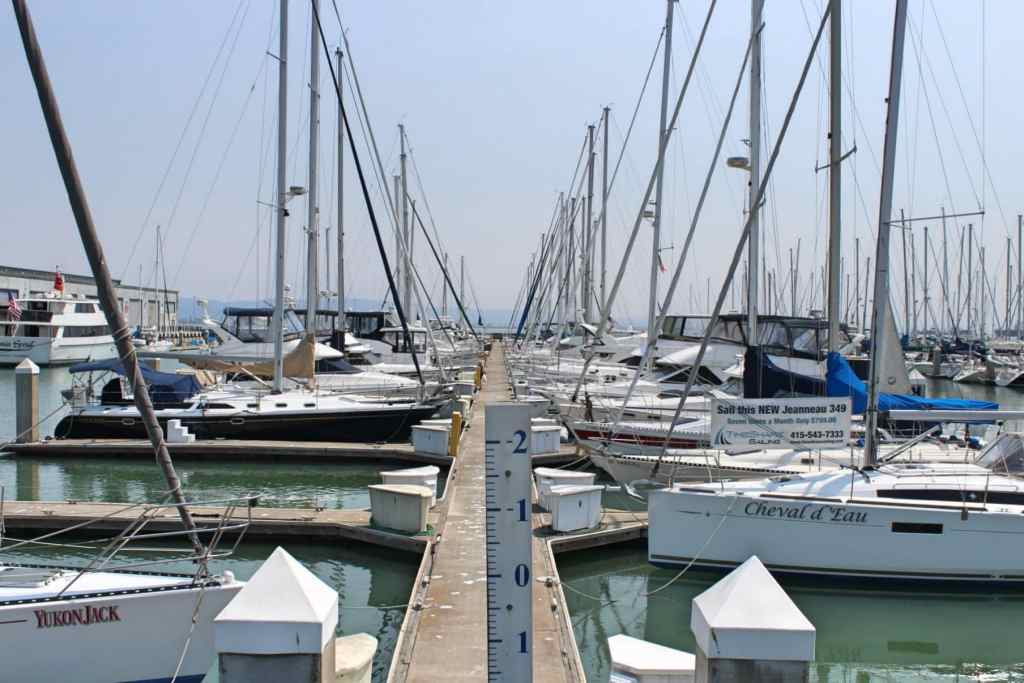
I walked along the water, enjoying the gentle breeze and the bright sun, pausing occasionally to examine anything that caught my eye. This certainly included the giant sculpture, Cupid’s Span, which consists of a huge bow and arrow that have been stuck into the ground. Designed by the artist team Claes Oldenburg and Coosje van Bruggen (who are married), the sculpture is meant to pay homage to San Francisco’s history as a city of love. (But to me it looks as though cupid had carelessly lost his weapon, which is not good news for would-be lovers.)

Next I passed the Ferry Building, which looks vaguely like a medieval city hall—with a large clocktower shooting up from a lower structure. This beaux-arts style building actually took its inspiration from the Giralda, the half-Moorish, half-Renaissance bell tower of Seville’s cathedral. As you may imagine, before the construction of the major bridges, ferries were quite important to the life of the city. But as time went on, the building came to be seen more and more as a historical monument, and parts were even rented out for use as office space. Nowadays, however, the building has regained some of its former luster, and is a tourist attraction in its own right—with a food court and a market in the “Grand Nave.” It is still the main ferry hub for the city.
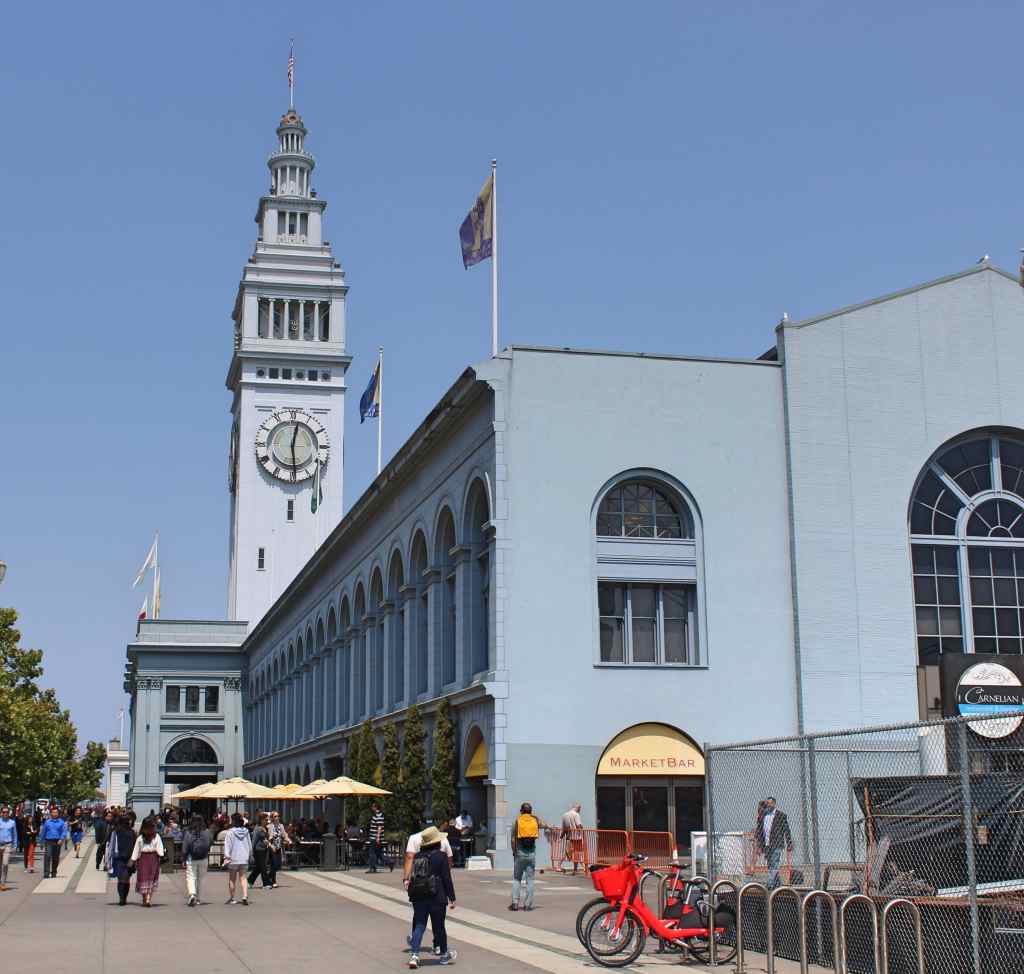
While I walked along, I noticed an interesting presence on the streets: big, hulking streetcars. This is the city’s historic streetcar service. Much like the city’s cable cars, these streetcars now mainly serve a nostalgic purpose, ferrying tourists in creaky wooden and metallic boxes across the city. But they really are quite charming to see, as they scuttle past like big colorful beetles. Incidentally, I also passed by the Fog City Diner, a landmark restaurant with a classic, retro appeal. I later ate here with my family, and the food was fantastic.
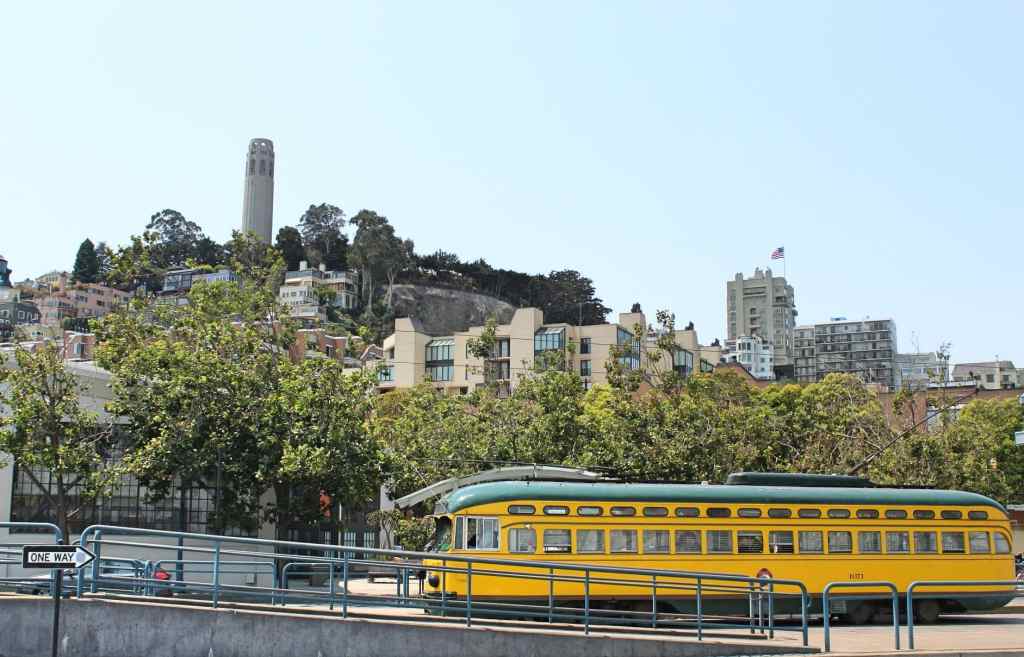
My next stop was Pier 39. This pier is one of the city’s major tourist centers, which means it is crowded and filled with all sorts of touristy junk. But the pier is still worth visiting, if only for the view. From the end of the dock, you can see both the Golden Gate and the Bay Bridge; and behind you there is Coit Tower and the Transamerica Pyramid. What most attracts attention, however, are the Sea Lions. A few decades ago, these animals preferred to lounge on the rocks near Cliff House, but for some reason they moved inside the bay and set up camp here. The sea lions took over these docks and have not budged since. The number of animals present on any given day fluctuated. When I visited, there were probably around 50; but there can be many times that number.

There are still more things to see from the pier. The SS Jeremiah O’Brien was docked not far off in the bay, a so-called Liberty ship. These were medium-sized cargo ships mass-produced during the Second World War, to ferry goods and men across the Atlantic. This particular ship has quite an impressive record, having been part of the D-Day Armada and seeing use in the Pacific Theater. The ship normally sits in the dock, available for tours; but occasionally it takes tourists on short rides.
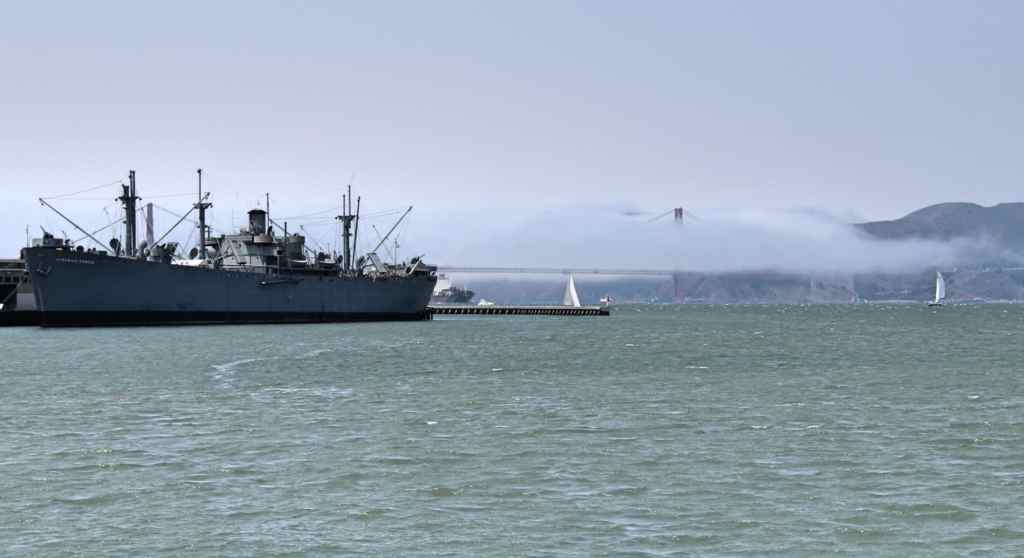
Yet by far the most famous thing in the bay is not a ship, but an island: Alcatraz. You may be surprised to learn that this name also dates back to the Spanish occupation. Nowadays, the word alcatraz is used to refer to garrets; but at the time the word was used for pelicans (both are white, coastal birds). Thus, Alcatraz is the island of the pelicans—as it remains, incidentally.
(It is also curious to note that this word—like virtually all the Spanish words that begin with “al-”—is a loan word from Arabic, dating all the way back to Moorish Spain. It most likely comes from al-ḡaṭṭās (in Arabic: الْغَطَّاس), which means “the diver.” So the name of one of the world’s most famous prisons comes from a Spaniard misidentifying a bird, using a word that was misheard from Arabic several centuries earlier. History is a funny thing.)
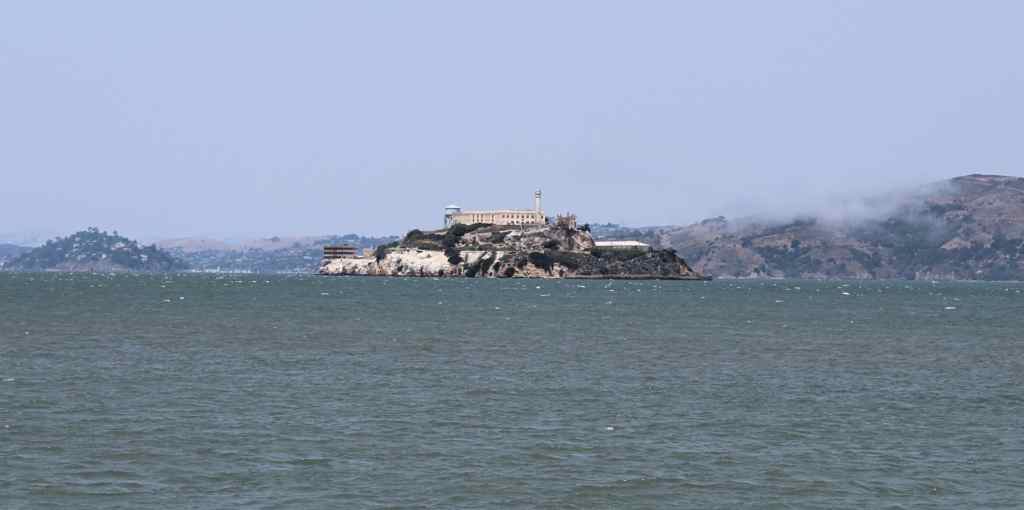
The last time I had been in San Francisco, I visited this island with my family. Nowadays, unfortunately, you need to have booked tickets in advance in order to visit, so we missed our shot. But I do have a strangely vivid memory of my time on this island. It is an arresting mixture of the wretched and the beautiful—with dark, concrete cells surrounded by ocean and sky. Because of the frigid waters and strong tides of the bay, the prison was considered escape-proof, though three prisoners tested this notion in 1962 (as dramatized in the classic film). The iconic gangster Al Capone was imprisoned here, as well as the famous “Bird Man” of Alcatraz, Robert Franklin Stroud, who did important work on bird diseases during his many years of imprisonment. (Alcatraz, however, did not let him have either birds or equipment.)
By now, I had had enough of the overpriced and gaudy seaside, so I headed to one of San Francisco’s great neighborhoods: Chinatown. San Francisco has a claim to being the most important city in Chinese-American history, as the city’s Chinatown—established in 1848—is the country’s oldest. Though New York City has a higher Chinese population in total, people of Chinese descent make up a greater portion (about a quarter) of San Francisco than NYC or anywhere else in America. As it happens, most of the residents in the Bay Area hail from southern China, where Cantonese rather than Mandarin is spoken (which explains why some services at St. Peter’s and St. Paul’s are offered in that language).
The most recognizable landmark in the neighborhood is the Dragon Gate—a stylized arch (called a pailou), with two fearsome guardian lions on either side. This was actually a gift from Taiwan, and was erected as a kind of PR stunt during the Korean War for the Chinese-American community (since the People’s Republic of China was fighting on North Korea’s side).

Two other notable landmarks are the Sing Fat and Sing Chong buildings, both on Grant Street. These feature an arresting combination of typical Western and Chinese building styles—looking like ordinary buildings that have grown ornamental frills, towers, and swoops. But elaborate architecture is not needed to know that you are in Chinatown. Every surface is covered with Chinese characters, and red lamps hang over the streets.
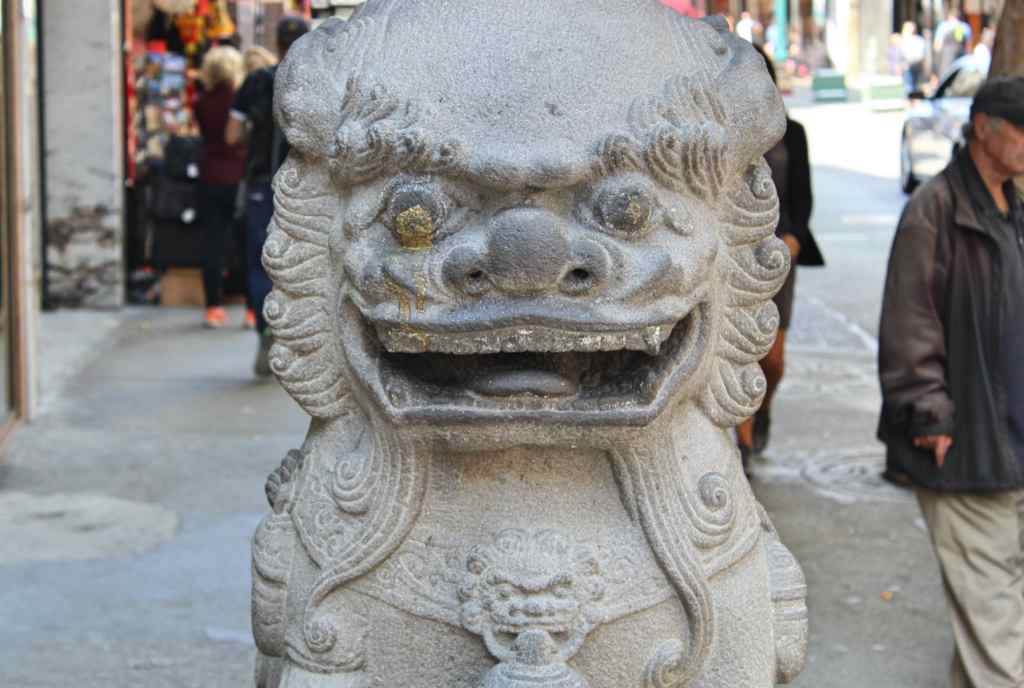
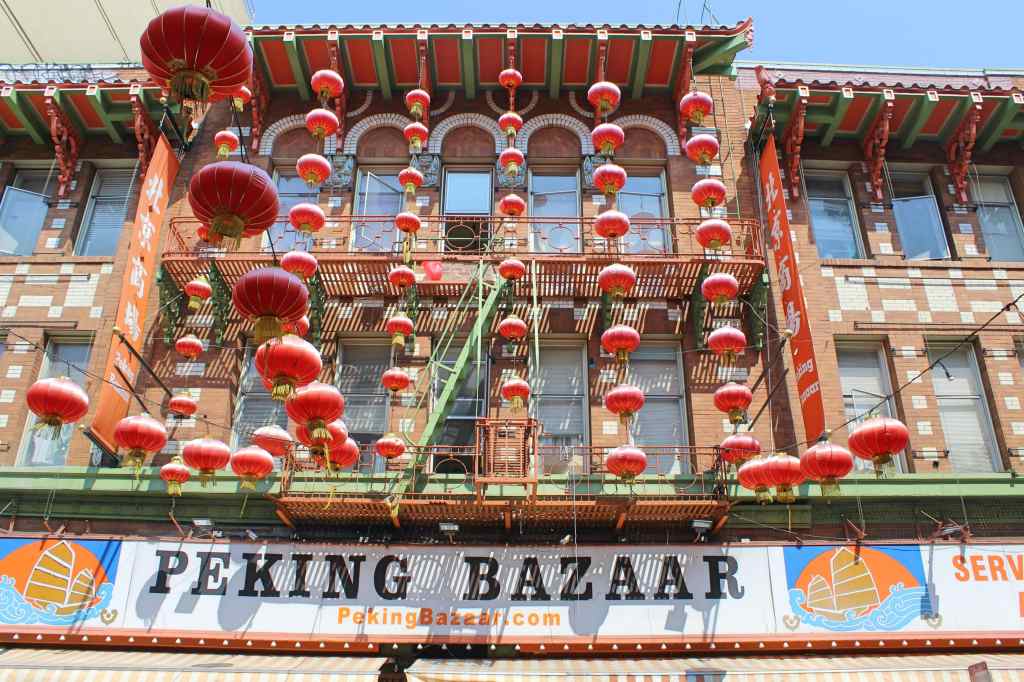
I had quite a bit of fun simply walking around. I love walking into Chinese grocery stores and food shops, as they are always full of unfamiliar products and brands, all of them wrapped in sparkling colors. As I walked by an alley, I spotted a couple men practicing a dragon dance. And I even paid a short visit to the Golden Gate Fortune Cookie Company, which is exactly what it sounds like: a small factory for fortune cookies. But the best part of visiting Chinatown was the food. I waited online at a dumpling shop and walked out with enough food for three people, all for less than $10. In San Francisco, where a ham sandwich can cost more than that, this is beyond a bargain. And it was delicious.

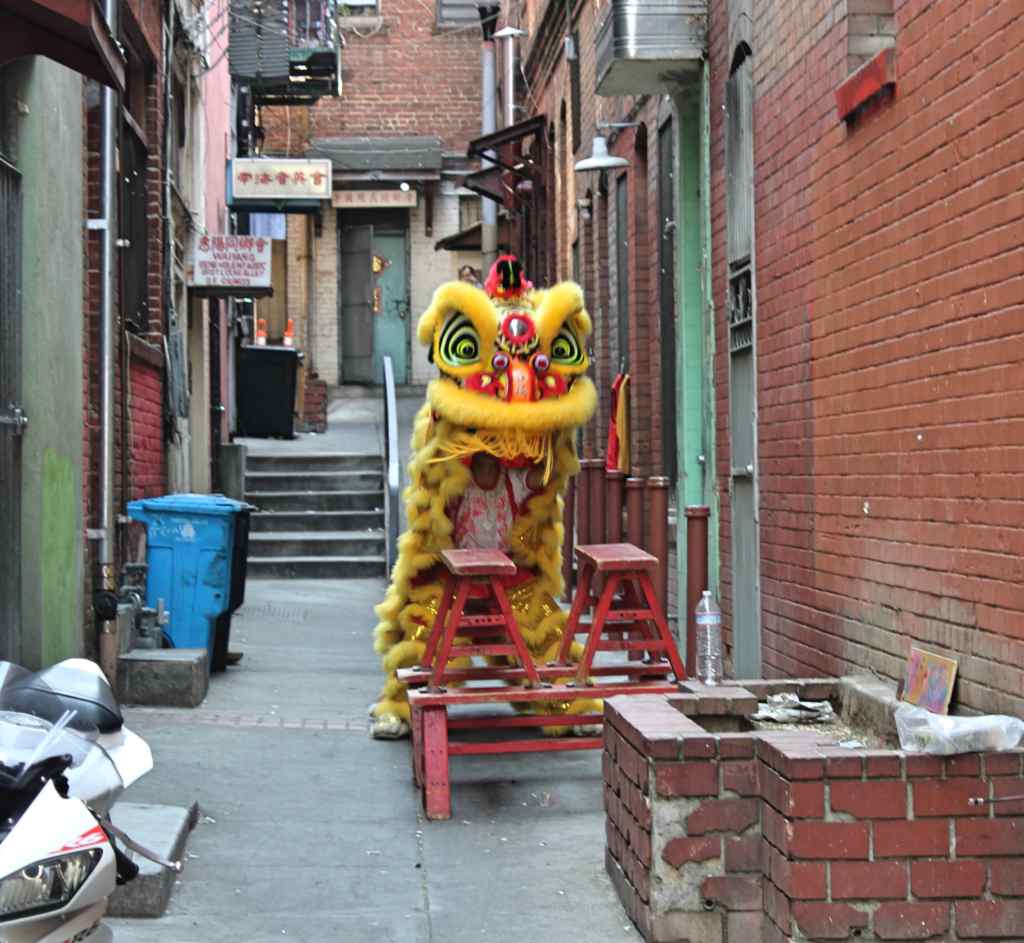
Next, I wanted to visit a museum. San Francisco has plenty to offer in that regard. There is the San Francisco Museum of Modern Art (SFMOMA), which has a vast collection of 20th century art, all housed in an appropriately daring building. There is the Legion of Honor, an imposing neoclassical building with a wide-ranging collection of (mostly European) art; and the de Young Museum, which mainly focuses on art from the United States. If you are looking for something a little more interactive, the Exploratorium—located on the Embarcadero—is full of participatory exhibits. (The museum was the brainchild of Frank Oppenheimer—a far more beneficent gift to humankind than Frank’s older brother’s gift of the atomic bomb.)
But I only had time for one museum, and the one which interested me the most was the Asian Art Museum. This museum is located right across from San Francisco’s city hall—a lovely Palladian structure with a gilded dome—as well as from the main branch of the San Francisco public library. The museum is an enormous institution in its own right, with one of the country’s great collections of Asian art. As I walked through the galleries—going from India, to China, to Japan—I found myself more and more deeply amazed, both at the quality of the collection and of the art itself, and once again filled with a burning desire to learn more about these cultures. But as I am, alas, still quite deplorably ignorant, I will let my photos do the talking:
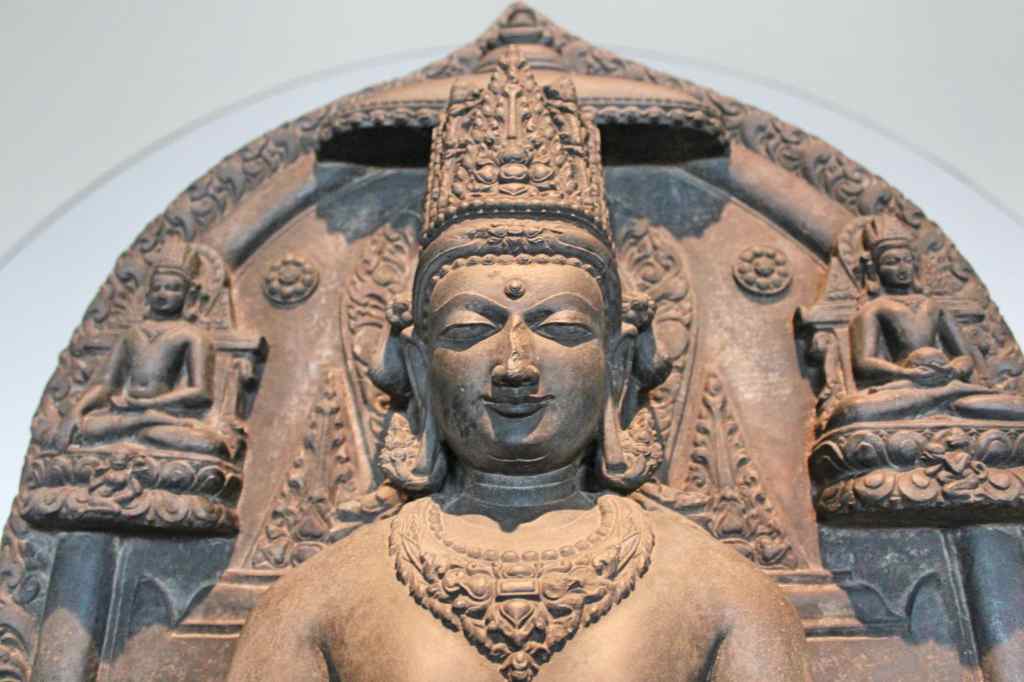



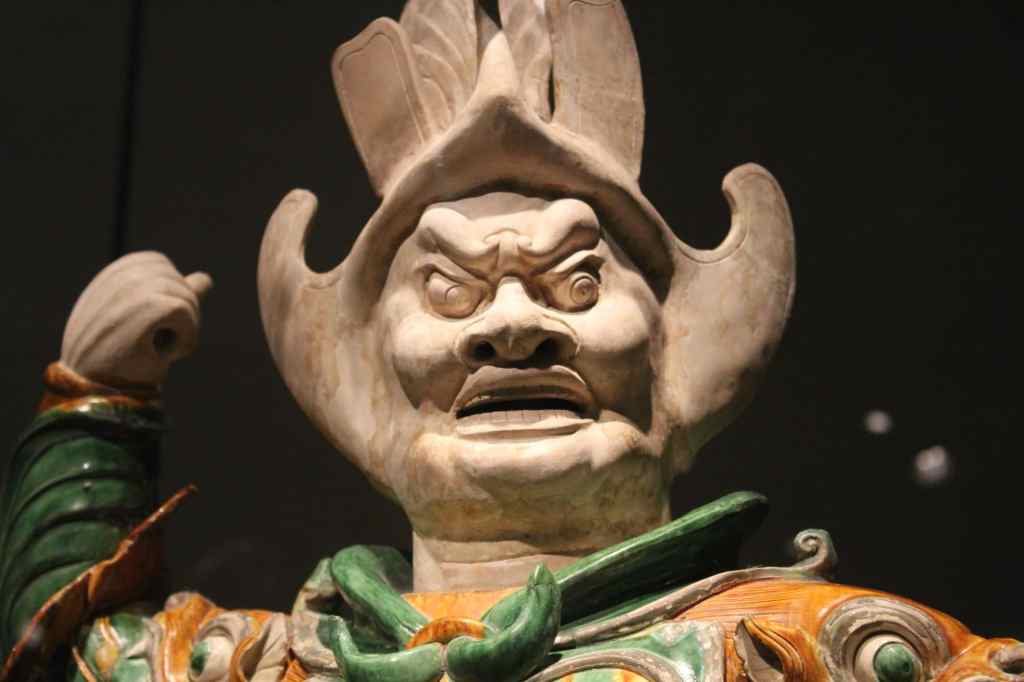
This concluded my last full day in San Francisco. It was late and I needed to get back to my Aunt’s house for dinner. So I made my way to the nearest BART station and was whisked back across the bay. But I still had time for a last glimpse of the city.
On one beautifully unfoggy day, I took BART into the city center. I was going to go on a bike ride with my cousins. And to get to our rendezvous-point, I had to walk through one of the most famous neighborhoods in San Francisco: Haight-Ashbury.
Of all the famous cultural moments in the history of San Francisco, the 1967 Summer of Love may be the most iconic. That summer, tens of thousands of hippies—dressed in tie-dye and bell-bottom jeans, taking every type of substance you can imagine—converged on the city in order to protest war, reject capitalism, and in general to imagine a different kind of world. It was one of the high points of the sixties counter-cultural movement, an event that helped to identify an entire generation. The moment was so notable as to even merit its own hit song: “San Francisco,” by Scott McKenzie. It summed up the moment thusly:
All across the nation
Such a strange vibration
People in motion
There’s a whole generation
With a new explanation
And indeed there was.
All hippiedom aside, the neighborhood is quite beautiful in itself, for its array of classic Victorian-style houses. These constitute perhaps the most distinctive buildings in the city—stately, elegant structures of wood and many windows, all scrunched up against one another in the city’s rolling hills. Residents have taken to painting them mellow, contrasting colors, leading to the popular nickname “Painted Ladies.” Personally, I found the neighborhoods quite charming. And I was also taken with the detectable aftershocks of the summer of love in the neighborhood, such as an “anarcho-syndicalist” bookstore (presumably one doesn’t have to pay?), and the coffee shop where I waited, which served a very nice brew in a space dominated by used books.
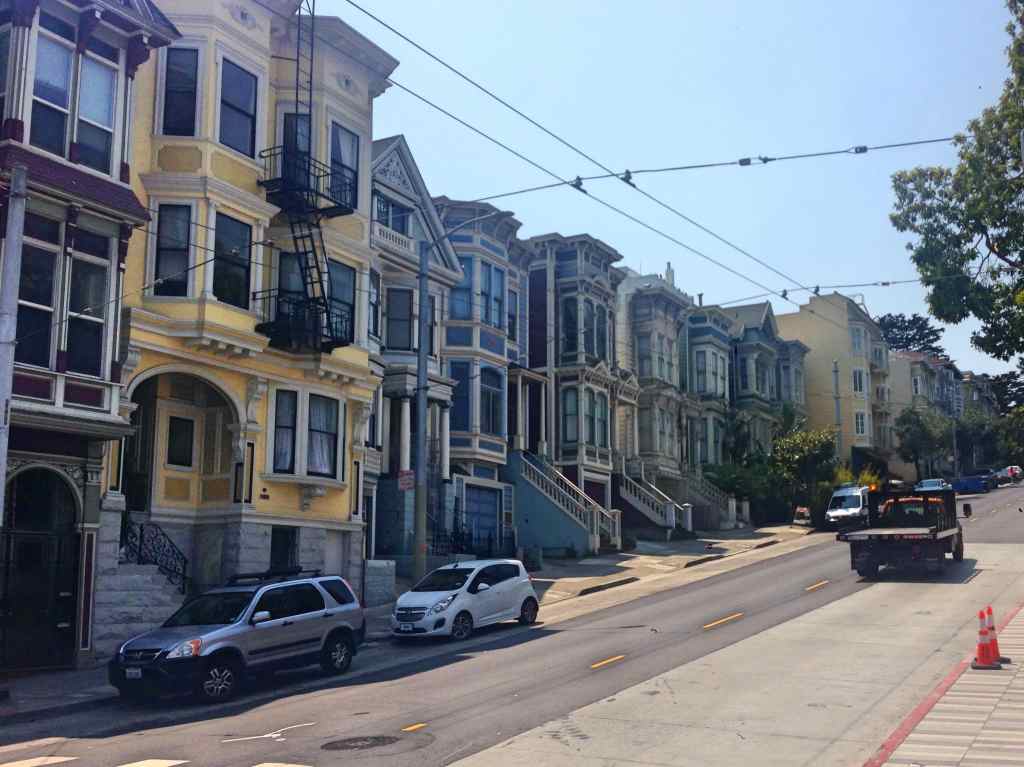
Finally it was time to assemble with my cousins. Within mere minutes, we had rented bikes and were pedalling our way through Golden Gate Park. If San Francisco’s Painted Ladies are the city’s equivalent to New York City’s brownstones, then the Golden Gate Park is the city’s Central Park. In fact, it is quite a bit larger than Manhattan’s greenspace, which is impressive in a city that is a fraction of NYC’s size. However, the two famous parks could never be confused by a visitor. Whereas Central Park is full of maples and oaks over a gently rolling field of grass, the Golden Gate Park has palm trees, eucalyptus, and cypress, which to me seemed quite beautiful and exotic.

Even more exotic were the bison, which were lounging casually in a field. This was almost certainly the first time I had ever laid eyes on a live bison. (There are stuffed ones in the American Museum of Natural History.) And, of all places, I did not expect it to happen in San Francisco. The park had purchased a herd back in 1899, when the country’s bison population was threatened; and it seems the habit of keeping bison is hard to kick.
We made our way through the patchwork of roads, paths, and bridges, until we came to a large open garden. This is where the de Young Museum (mentioned above) is located, as well as the California Academy of Sciences. But I was more interested in a lovely sculpture of two of my heroes, Don Quixote and Sancho Panza, praying to their creator Cervantes—yet another echo of Spain in this Californian city. We dismounted and walked for a bit, enjoying the sun and the bird calls (most of which were entirely unfamiliar to me), until we came to the park’s end.

Suddenly, the sky opened up and the land expanded into a sandy beach: the very literally-named Ocean Beach. There were a few scattered surfers in the distance (which caused my cousin’s boyfriend, an Australian, keen envy). Behind me, I observed a beautiful Dutch-style windmill, which had been constructed in 1903 as a tasteful way of pumping water into the park.
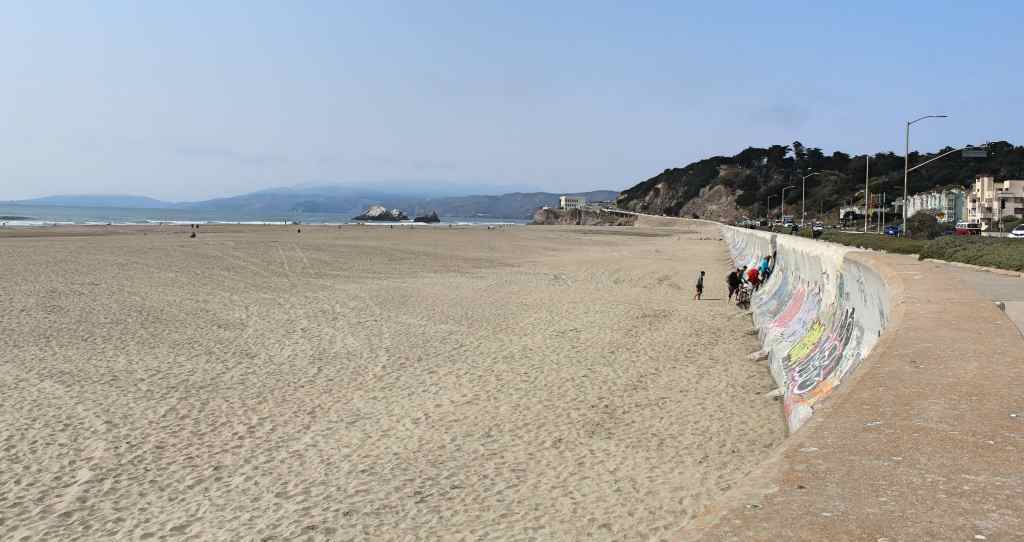
My time in the city was quickly coming to an end. We pedalled back to the other side of the parks, returned the bikes, and then had dinner in a bar. Soon, I was on the BART, heading back to the suburbs.
Inevitably, I missed a great deal during my trip. I would have liked to have visited more museums and to have seen Alcatraz once again. I also regret not paying a visit to the Castro District, one of the country’s most important gay neighborhoods. It was here that Harvey Milk became the nation’s first openly gay elected official, before his gruesome assassination. It was also here that the nation first came to grips with the horrible AIDS epidemic of the 1980s.
San Francisco is, without a doubt, one of the great American cities. Its history is fascinating, and its personality is unmistakable. Yet the city I had seen was very different from the city of Allen Ginsberg, Scott McKenzie, and Harvey Milk. Nowadays, San Francisco is the city of Mark Zuckerberg, Steve Jobs, and Elon Musk. Whether or not this is an improvement, I will let its residents decide.
Soon enough I was walking through the airport gate, back into JFK. And it was not long before someone was yelling rudely. It felt good to be home.
Review: A Journal of the Plague Year
A Journal of the Plague Year by Daniel Defoe
My rating: 3 of 5 stars
It was a very ill time to be sick in…
My pandemic reading continues with this classic work about one of the worst diseases in European history: bubonic plague. Daniel Defoe wrote this account when the boundaries between fiction and non-fiction were looser. He freely mixes invention, hearsay, anecdote, and real statistics, in pursuit of a gripping yarn. Defoe himself was only a young boy when the Great Plague struck London, in 1664-6; but he writes the story in the person of a well-to-do, curious, if somewhat unimaginative burgher, with the initials “H.F.” The result is one of literature’s most enduring portraits of a city besieged by disease.
Though this account purports to be a “journal,” it is not written as a series of dated entries, but as one long scrawl. What is more, Defoe’s narrator is not the most orderly of writers, and frequently repeats himself or gets sidetracked. The book is, thus, rather slow and painful to read, since it lacks any conspicuous structure to grasp onto, but approaches a kind of bumbled stream-of-consciousness. Even so, there are so many memorable details and stories in this book that it is worth the time one spends with it.
The Great Plague carried off one fourth of London’s population—about 100,000 souls—and it was not even the worst outbreak of plague in the city. The original wave of the Black Death, in the middle ages, was undoubtedly worse. Still, losing a quarter of a city’s population is something that is difficult for most of us to even imagine. And when you consider that the Great Fire of London was quick on the plague’s heels, you come to the conclusion that this was not the best time to be a Londoner.
What is most striking about reading this book now is how familiar it is. The coronavirus is no bubonic plague, but it seems our reactions to disease have not come a long way. There are, of course, the scenes of desolation: empty streets and mass graves. The citizens anxiously read the statistics in the newspaper, to see if the numbers are trending upwards or downwards. And then there are the quacks and mountebanks, selling sham remedies and magical elixirs to the desperate. We also see the ways that disease affects the rich and the poor differently: the rich could afford to flee the city, while the poor faced disease and starvation. And the economic consequences were dreadful—shutting up business, leaving thousands unemployed, and halting commerce.
Medical science was entirely useless against the disease. Nowadays, we can effectively treat the plague with antibiotics (though the mortality rate is still 10%). But at the time, little could be done. Infection with the bacillus causes swollen lymph nodes—in the groin, armpits, and neck—called buboes, and it was believed that the swellings had to be punctured and drained. This likely did more harm than good, and in practice the plague doctors’ only useful purpose was to keep records of the dead.
Quite interesting to observe were the antique forms of social distancing (a term that of course did not exist) that the Londoners practiced. As now, people tried to avoid going out of their homes as much as possible, and if they did go out they tried to keep a distance from others and to avoid touching anything. Defoe describes people picking up their own meat at the butcher’s and dropping their money into a pan of vinegar to disinfect it. There was also state-mandated quarantining, as any house with an infection got “shut up”—meaning the inhabitants could not leave.
Ironically, though these measures would have been wise had the disease been viral, they made little sense for a disease communicated by rat fleas. (Defoe does mention, by the way, that the people put out rat poison—which probably helped more than all of the distancing.)
One more commonality is that the virus outlasted people’s patience and prudence. As soon as an abatement was observed in the weekly deaths, citizens rushed out to embrace each other and resume normal life, despite the warning of the town’s physicians. Not much has changed, after all.
So while not exactly pleasant to read, A Journal of the Plague Year is at least humbling for the contemporary reader, as it reminds us that perhaps we have not come so far as we thought. And it is also a timely reminder that, far from a novel and unpredictable event, the current crisis is one of many plagues that we have weathered in our time on this perilous globe.
[Cover photo by Rita Greer; licensed under FAL; taken from Wikimedia Commons.]
View all my reviews
Quotes & Commentary #76: Thucydides
Reckless audacity came to be considered the courage of a loyal ally; prudent hesitation, specious cowardice; moderation was held to be a cloak for unmanliness; ability to see all sides of a question inaptness to act on any. The advocate of extreme measures was always trustworthy; his opponent a man to be suspected.
—Thucydides
In my previous post I bemoaned the conversion of a public health crisis into yet another partisan fight—with those on the left for the lockdown, and those on the right against it. In this regard, I think it is striking to reread this passage of Thucydides, as it encapsulates a common occurrence in times of crisis: the preference for extreme measures over moderation, for decisiveness over prudent hesitation.
The reason for this is our very human need to feel safe and secure. Having a plan, especially a drastic plan, is one of the ways we accomplish this. Carrying out extreme measures at least gives us the illusion of control; and control is what everyone craves in an emergency. But I do not think we should let this very human need prevent us from being critical, open-minded, and moderate. These are good qualities in the worst of times as well as in the best of times.
My main concern is that I think that too many people—especially on the left—are advocating long, strict lockdowns as the only possible option. Calls to reopen are being dismissed as irresponsible or even nefarious, and respected epidemiologists like David Katz (who advocates more measured policies) can only get a hearing on Fox News and Bill Maher’s show. This makes me worry that the left is backing itself into an ideological corner, insisting that lockdowns are the only way to fight this virus.
There is certainly a noble impulse in this: valuing human life over profit. But I think that the situation is far more complex than this dichotomy implies. A narrative is starting to emerge that it is our evil corporate overlords (Elon Musk, most notoriously) who want us to return to work in order to satisfy their greed. Already in Georgia, people are compiling lists of businesses which are reopening with the intention of blacklisting them for doing so. But are we really willing to vilify people for reopening when remaining closed would mean bankruptcy, financial ruin, and losing their livelihoods? The anti-corporate, pro-lockdown messaging is ignoring the simple truth that the economic effects of the lockdowns will hurt the poor far, far more than they will hurt the rich.
Granted, we could and should be doing much more to help the poor and disadvantaged during this time. Also granted, our economy was rife with structural inequalities before all of this, which ought not to have been there to begin with. But we must work with the economy we have and with the options that are politically possible—not with the economy we should’ve had and the things we should be able to do. And we also must be sure that our policies are shaped by prudence rather than fear or ideology.
So here is my worry: if the left (of which I consider myself a member) becomes the party of lockdowns, this may not appear so wise in retrospect. This is because the efficacy of our anti-virus measures is still very much an open question; and it is thus very possible that some of our policies will have done more harm than good.
As a prime contender for this, I would submit school closures. As I noted in my previous post, young children seem both safe from, and hardly able to transmit, the virus. The idea that they were major transmitters was an educated guess, and it seems to have been wrong. Keeping children out of school, however, will undoubtedly be harmful to their development and detrimental to their futures. And it will most certainly do the most harm to the poorest among us. Furthermore, keeping children home puts more pressure on parents, and may take some doctors and nurses out of commission.
At the very least, I think it is wrong to close schools in a “better safe than sorry” mentality, without very thorough consideration of the costs and benefits. As a teacher myself, I can say with confidence that virtual learning is no substitute for being in the classroom. If my students must miss class, I want to be sure that it is to protect them, and not simply to make us feel safer. I am not willing to sacrifice their education to satisfy my panic.
Here is the trouble with a total lockdown: it combines so many different measures into one sweeping global approach that we have no opportunity to see which specific parts of the lockdown—closing restaurants, canceling concerts, calling off school—have the highest cost-benefit ratio. It simply cannot be taken for granted that a total lockdown is the single best strategy going forward. In the absence of more data about the virus’s lethality and total spread, we cannot even be confident that it was even a wise strategy to begin with. (A study by the Wall Street Journal—which admittedly has its own biases—found that there was no correlation at all between coronavirus mortality and the speed of lockdown in U.S. states.)
The case of Sweden should give lockdown advocates pause. Sweden has become notorious for its lax coronavirus measures. Shops and restaurants are open, and life carries on without masks or gloves. Meanwhile, most other European countries instituted strict lockdowns. Spain had one of the strictest lockdowns of all. Parks were closed, and people were not allowed to go on walks or to exercise outside. All non-essential businesses were shuttered, and people could only leave the house to go to the pharmacy and the supermarket. Police patrolled the streets, giving out hundreds of thousands of fines, and making hundreds of arrests, in enforcement of the lockdown.
If lockdowns were really an effective way of controlling the virus, then one might expect Spain to have a substantially lower death rate. On the contrary, Spain has suffered twice as many deaths-per-million as Sweden. Indeed, Sweden is in the ballpark of Ireland and Switzerland, two countries that took swift, decisive action to shut down their economies. And Sweden’s “curve” seems to be leveling out anyway. To say the very least, it has not been an unmitigated disaster in the country.
Admittedly, if you compare Sweden to its Scandinavian neighbors, Finland and Norway, you can see that their lax policy seems to have resulted in a higher mortality rate. Does this prove that Sweden has taken the wrong course? I think we should not rush to judgment. First, it is easily possible that, as Finland and Norway open up, their death rates will climb to approach Sweden’s. Furthermore, by minimizing the damage done to their economy, there is a very real possibility that Sweden inflicted less total harm on its society.
(We also should not rush to declare New Zealand’s tough policies a success, which for the moment seems to have eliminated coronavirus from their shores. While this is impressive, it remains to be seen whether this was the best strategy for the long-term, since it is possible that it will only make it that much more difficult to reestablish open channels with the outside world.)
My own personal fear—which apparently is not shared by many—is that the left will put itself in a bad position if it becomes the party of the lockdown. At the present moment, there is an awful lot of fear of this new virus. But in six months, when the elections roll around, what will be at the forefront of people’s minds: the virus, or the economic depression?
My guess is that, as time goes by, fear of the virus will fade, and concern for ruined businesses, blasted retirement accounts, and lost careers will only grow more acute. So far, it seems that Republicans have shifted most decisively in the direction of economic concern, with Independents shifting somewhat in that direction, while Democrats have hardly budged.
Such flagrantly political concerns should not guide our policy. Concern for human welfare should. And I am afraid that we may be developing myopic and unrealistic ideas about the lockdowns in this regard. First, somewhere along the line, many people seemed to have forgotten that our original idea of “flattening the curve” was to prevent the healthcare system from being overwhelmed. The idea was never that we would absolutely prevent people from getting sick. Unless we are willing to stay inside until a vaccine is widely available—an unknown timeline, but still many months away—we are simply going to have to accept some risk from the virus.
Now, perhaps some rich countries could afford to stay shut up indoors until we have a vaccine. And maybe this would benefit these rich countries (though I doubt it). However, I think such a prolonged and severe period of economic inactivity would be horrendous for poorer countries. Telling people to stay inside is simply not feasible where people live in shacks and have no savings. And governments in poor countries could not afford drastic social policies to keep their people fed, especially during a severe depression. (Remember that a depression in richer countries means a depression everywhere.) A months-long lockdown could easily result in food shortages in many parts of the world, which might claim significantly more lives than the virus itself.
What is more, prolonged economic depression has serious political repercussions. Economic instability easily translates into political instability, and political instability easily translates into violence—even war. The 2008 financial crisis has already had an awful effect on worldwide politics, eventually resulting in waves of populist right-wing parties, and a growing polarization which has resulted in increasingly dysfunctional governments. And this is only to speak of rich countries.
In countries already struggling with low standards of living and ineffective governments, what will be the results of an economic crisis much more severe than 2008? Will every government be able to take the pressure? We must keep in mind that, if any government fails, the consequences will be bad for everyone. As we have learned, power vacuums leave the door open for the most dangerous among us to gain control.
For those of us on the left, I think it behooves us to examine the complete picture, and not to fall into easy rhetoric about workers being sacrificed for the economy. These are the hard facts: the virus is here to stay; and if the economy is not working, it will be very, very hard on millions of people—especially poor people all around the world. Our governments could and should do more to alleviate the economic suffering. But many countries around the world simply do not have the resources to do so, and a severe depression will only make this more true. Of all people, we on the left should know that poverty hurts and kills, and we cannot afford to turn this into yet another purity test.
The hardest truth of all, perhaps, is that we are in a horrible situation that requires us to make painful compromises. An ideology that promises easy answers and readily-identifiable villains will not get us very far.
Quotes and Commentary #75: Franklin
So convenient a thing is it to be a reasonable creature, since it enables one to find or make a reason for everything one has a mind to do.
—Benjamin Franklin
Our brain has an astounding ability to formulate justifications for believing things that we want to believe. As I have already remarked, the current pandemic—a major historical event—seems to have changed nobody’s mind. Socialists are calling for universal healthcare, capitalists are calling for corporate bailouts, and in general the old battle political lines are as strong as ever.
Indeed, at a time one might expect people to turn towards experts, I have observed some even embracing—of all things!—anti-vaccination. Really, if a pandemic cannot convince somebody that viruses really do cause disease and that we ought to prepare for them, then I do not see much hope for reasoned debate.
Considering that our collective response to a novel virus has somehow turned into a partisan fight, then I do think there is ample reason to suspect that many of us are not reacting rationally. And there are powerful emotional reasons for this. Specifically, I think that we have been impaled on the twins horns of fear and foolhardiness.
A part of our brains is terrified of contagion and disease, while another part is prone to wishful thinking. And it seems that these two emotional reactions are coming to dominate the two sides of the political spectrum: the left is fearful, while the right is foolhardy. The problem is that I think both emotions lead to irrational and unsustainable responses.
Giving into fear means embracing long and even indefinite lockdowns. Better to be safe at home than putting oneself and others outside at risk. And of course this is not wholly unreasonable: the coronavirus is real, and it has taken lives. My concern is that the original justification for the lockdowns is being forgotten. The idea of “flattening the curve” was to prevent our healthcare systems from being overwhelmed, which was a real danger in places like Madrid and New York City. The idea was that, if we flatten the curve, we will save lives—not by reducing the total number of infections, but by spreading out the infections so our healthcare system could handle them.
But somehow this thinking got lost, and I am afraid that there are many who think we can somehow eliminate the virus altogether by staying inside. The virus will be there, waiting, whenever we leave our homes. A virus has no timeline and infinite patience. So unless we are willing to wait until a vaccine has been invented, mass-produced, and widely distributed—which will be such a long time that it could cause unprecedented economic harm—then the only reason to wait, as far as I can see, is to make sure our hospitals will be able to handle the influx of patients. In places where the healthcare system is not nearly at maximum capacity, I do not see what would be gained by an extra month of waiting inside, other than allowing people to feel safe a little longer.
Demanding long, strict lockdowns even in areas where the virus is not widespread strikes me as a response motivated primarily by fear. And the problem with fear is that it gives you tunnel-vision, focusing all your attention on the source of danger, and reorienting all of your priorities around the new threat. This can lead to some obviously irrational behavior—in nearly all of us.
For example, a person may refuse to walk across a bridge because of his fear of heights, but may smoke cigarettes and drink heavily (much more serious risk factors for health) on a regular basis. Collectively we may focus frantic attention on a mining disaster that kills dozens—launching inquiries and investigations and instituting reforms—while we completely ignore hospital-acquired infections, which kill tens of thousands year after year. The human brain is wired to respond to immediate threats, and especially the kinds of threats (like violence and disease) that shaped our evolution. Much more serious threats, which kill through slower and less spectacular means, are easier to ignore. (Global warming is probably the best example of this.)
The problem with our great fear of the virus is that I think it may cause us to neglect the costs of our containment measures. The success of a country’s policies cannot be measured in the number of its coronavirus cases and deaths alone. A profound and prolonged economic depression will both reduce lifespans and, directly and indirectly, also cause deaths. But the suffering caused by the depression will be slower, longer, less spectacular, and thus less scary. However, such damage is just as real, and it is just as much a consequence of our policies.
As I have argued before, a truly moral response to the crisis requires that we try to reduce harm as much as possible, all across the board. Fearfully focusing our attention exclusively on the coronavirus will lead us to be not only irrational, then, but potentially immoral.
Let me give a concrete example of this. From what I can tell, there is a growing amount of evidence that young children are in negligible danger from the virus. Moreover, according to this study performed in Australia, children are apparently not even a significant source of contagion. Indeed, in Switzerland they are apparently confident enough that children do not pose a danger that they have given young kids permission to hug their grandparents.
If it is true that children neither pose nor suffer a significant risk, then that would make many of our school closures questionable at best. In Spain, for example, schools will not reopen until the fall. But keeping kids out of school does serious, lasting harm to them—harm that disproportionately falls on poorer students, and harm that must also be taken into account when we make policies. (Also, Spain’s policy of keeping children confined in their homes for 6 weeks also seems hard to justify in this light.)
My point is not to advocate for school reopenings, per se (though it does seem reasonable to me), but to make the more general point that the current environment of fear makes even a rational discussion about school closures impossible. Instead of balancing the risks and rewards to students, many on the left seem to instinctively dismiss such conversations as frivolous and irresponsible. I do not think this is a productive mindset.
The mirror image of fear is foolhardiness, and I can sense it taking hold in certain sections of the right. We see it most clearly in the demonstrations in front of state capitals, in which participants deliberately flout safety guidelines in order to demand an economic reopening, often for pretty superficial reasons (like a haircut). It seems that many people still believe that the virus is not a significant threat and does not require any special action. But judging from what happened both here in Madrid and in my own state of New York, I think there is ample evidence that this virus is, minimally, a significantly greater threat than the seasonal flu. A policy of “do-nothing” is clearly inadequate when bodies are outstripping coffin-production and morgue capacity.
Foolhardiness also leads to another kind of cognitive blindness: wishful thinking. We all have the tendency to grasp at any data which supports our hoped-for conclusions. We can see this at work in a viral video of a certain Dr. Daniel Erickson (since removed from YouTube), who claimed that the data showed that coronavirus was, in fact, already widespread and far less deadly than the flu. But his argument was a product of wishful thinking, and rested on a basic error of statistics—extrapolating from a non-representative sample.
Erickson used our current coronavirus test records to extrapolate to the entire population. This does not take into account the obvious fact that most testing is done on people who are sick or who otherwise suspect they may have the virus. Our testing records, then, will obviously show much higher rates of coronavirus than the general population. Extrapolating from this data is simply nonsense. However, this video gained traction in rightwing circles and was even used on Fox News to argue against the lockdown.
A rational and moral response will be neither fearful nor foolhardy, but will take measures to minimize the total harm to society—both from the virus and the economic downturn. This is easier said than done, of course, especially in the world of politics. Personally, I think this is the ideal time to try out something like Universal Basic Income, which I think would ease the economic pressure and also give us more flexibility in combating the virus. But sadly this does not seem likely.
Given the real possibilities, then, I think that it is our obligation to cut the best path we can through both fear and foolhardiness, balancing the risk posed by the virus against the risk posed by a major economic depression. This means that we cannot let our fear of the virus be the only factor we consider; but we also cannot let wishful thinking cloud our judgment.
Acting rationally means fighting against the universal human tendency to give in to our hopes and fears. Both hope and fear, in different ways, distort the real danger.







